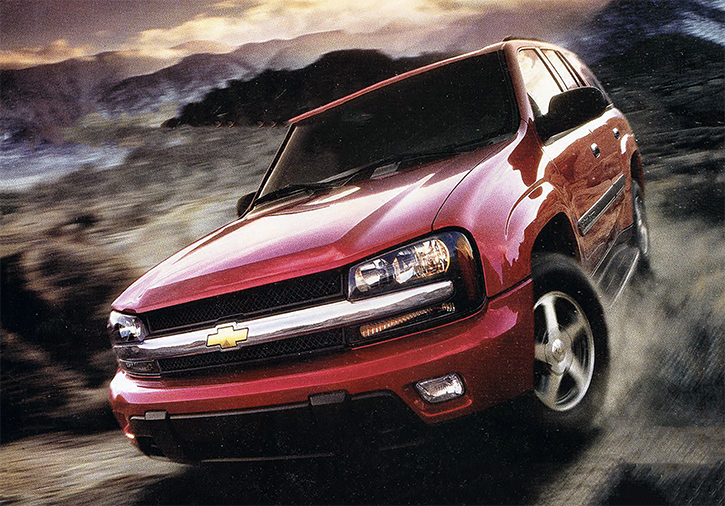
2002 Chevrolet Trailblazer
I joined the Consumer Guide team the summer of 2002. That means that, in just a few months, I will have been writing about cars full-time for 20 years. I mention this because I have only recently begun to consider just how much the automotive landscape has changed in the past two decades.
Most obviously, crossovers and SUVs have replaced traditional passenger cars as the general public’s preferred mode of personal transportation. High-technology “driver assistance” features that were barely even considered in 2002 are now commonplace, and often standard equipment. Recall that backup cameras–now a federally mandated safety feature–weren’t even available on new cars back in ’02.
Pickup trucks have changed, too. In some of their high-end trim levels, Ram pickups now rival top luxury-brand vehicles in terms of cabin refinement, and the regular-cab body style is now near extinction.
It saddens me a little that I am among the few people to recall—let alone care about—a failed attempt to resurrect the Studebaker brand that took place about 15 years ago. I also need to point out that the Kia Sedona minivan now starts around $31,000–considerably more than the $19,000 teased in the ad below.
Collected here are 12 car and truck ads–all but one of them from 2002. (We fudged a bit by including a 2003 Honda Civic Hybrid ad, but since the Civic Hybrid debuted in the spring of 2002 as an early 2003 model, it’s not much of a stretch.) I don’t know how nostalgic you feel yet about the cars of this century, but a close look at the ads below will demonstrate just how much things have changed. Of the dozen cars, seven are no longer in production, and two of the brands seen here are also now defunct. What big changes have you noted over the past 20 years? The place to leave comments is down below.
A Gallery of Car Ads from 2002
Chevrolet Trailblazer
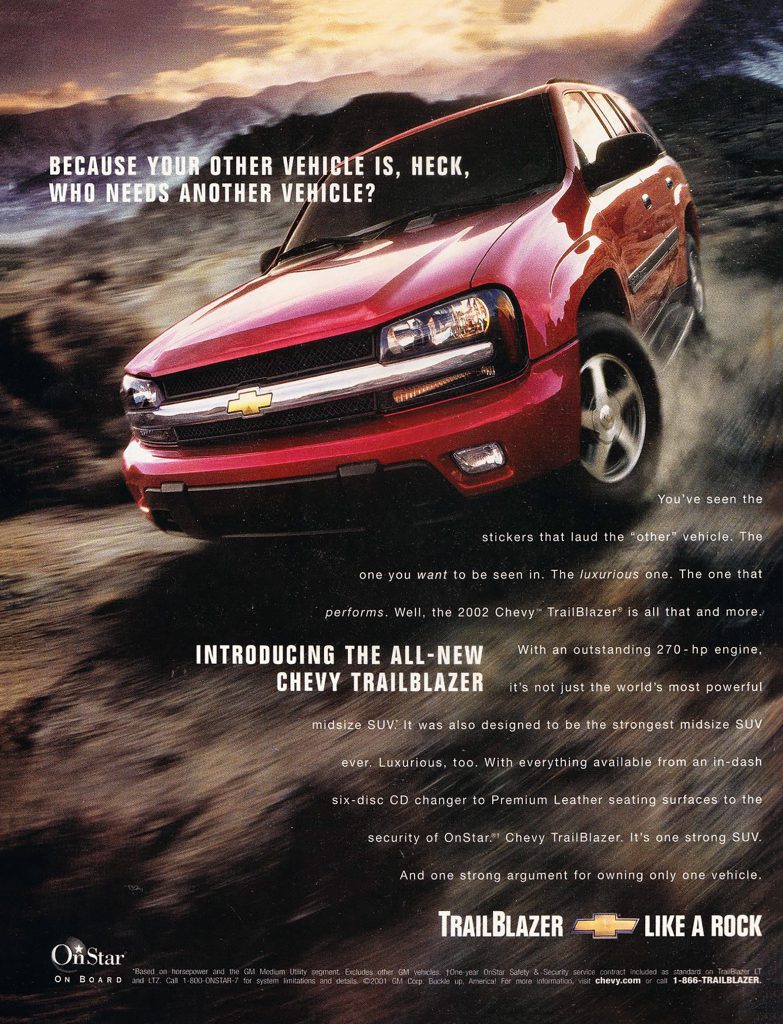
2002 Chevrolet Trailblazer Ad
Test Drive: 2021 Chevrolet Trailblazer LT
Chrysler PT Cruiser

2002 Chrysler PT Cruiser Ad
Review Flashback! 2007 Chrysler PT Cruiser
Ford Escape
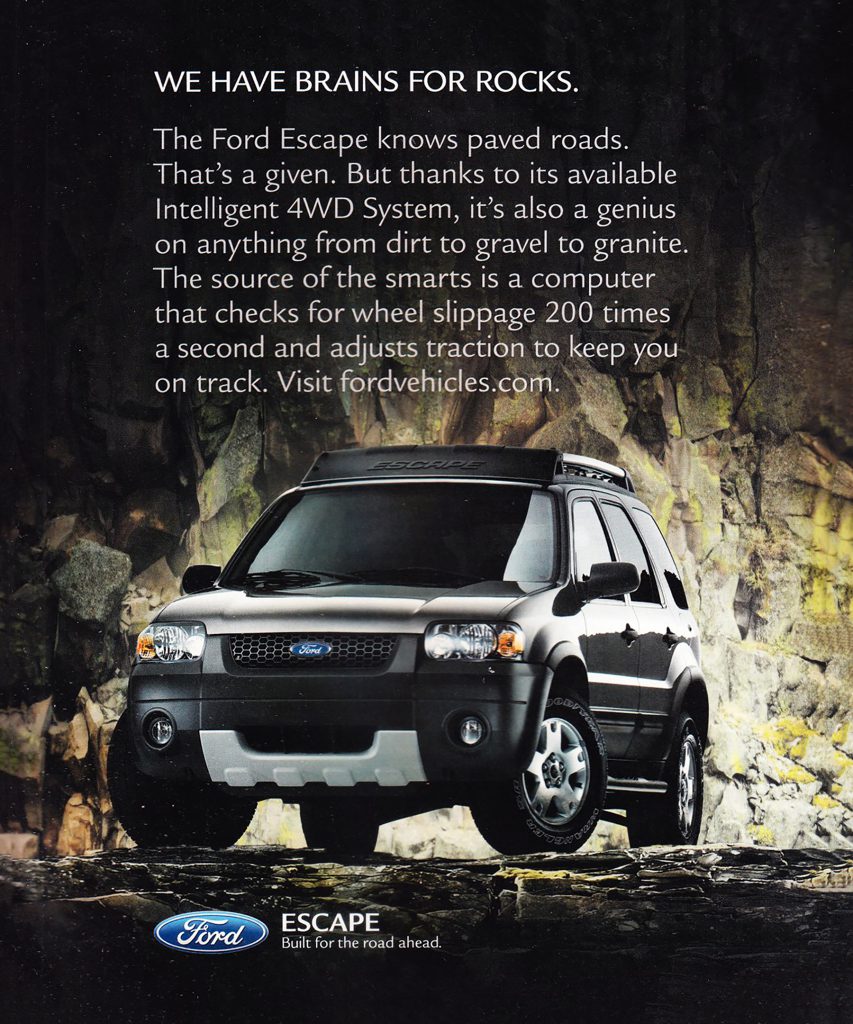
2002 Ford Escape Ad
Test Drive: 2020 Ford Escape Hybrid
Honda Civic Hybrid

2003 Honda Civic Hybrid Ad
Honda Civic Growth Curve: 1986 Versus 2016
Jeep Liberty
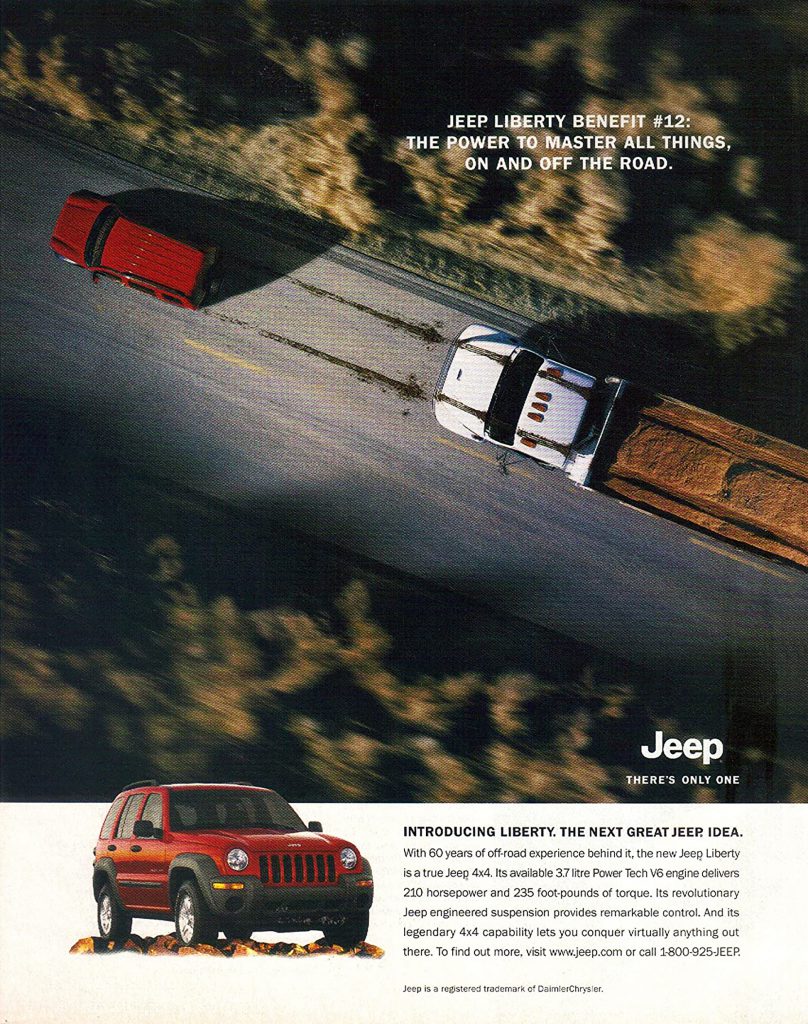
2002 Jeep Liberty Ad
Jeep Liberty: A Lesson in “Old Skool”
Kia Sedona

2002 Kia Sedona Ad
Forgotten People-Movers: More than 30 Minivans You Don’t Remember
Lexus RX 300

2002 Lexus RX 300 Ad
The 4 Most Important Vehicles of the Past 30 Years
Mercury Mountaineer
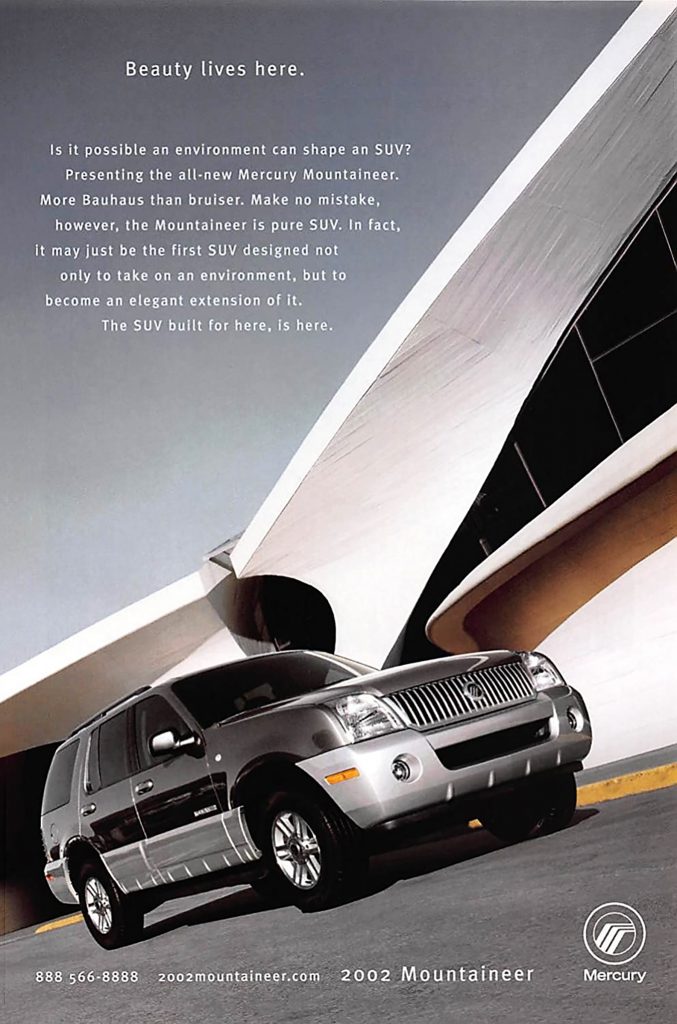
2002 Mercury Mountaineer Ad
5 Discontinued Trucks You’ve Totally Forgotten About
Pontiac Grand Prix GTP

2002 Pontiac Grand Prix GTP Ad
Cheap Wheels: 2000 Pontiac Grand Prix GTP Daytona 500 Pace Car Replica
Subaru Outback

2002 Subaru Outback Ad
Review Flashback! 2006 Subaru Baja
Toyota Celica

2002 Toyota Celica Ad
5 Cheap Coupes You’ve Completely Forgotten
Volvo Cross Country
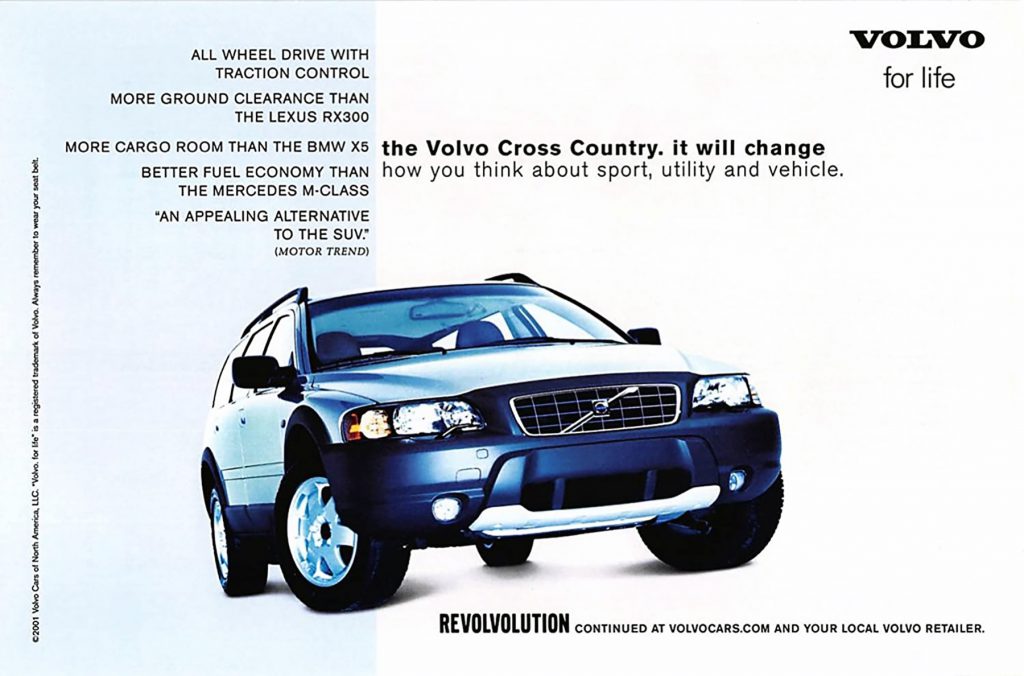
2002 Volvo Cross Country Ad
Click below for enlarged images
Listen to the very entertaining Consumer Guide Car Stuff Podcast
2002-Model-Year Ads Gallery
Car Ads from 2002
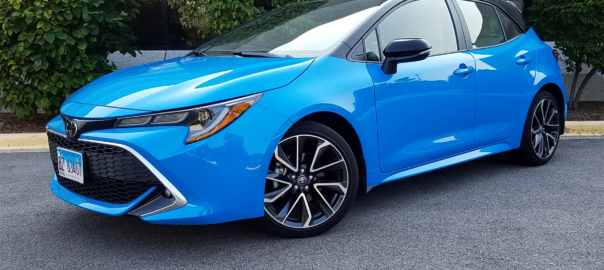
Quick Spin: 2020 Toyota Corolla Hatchback XSE (Manual)
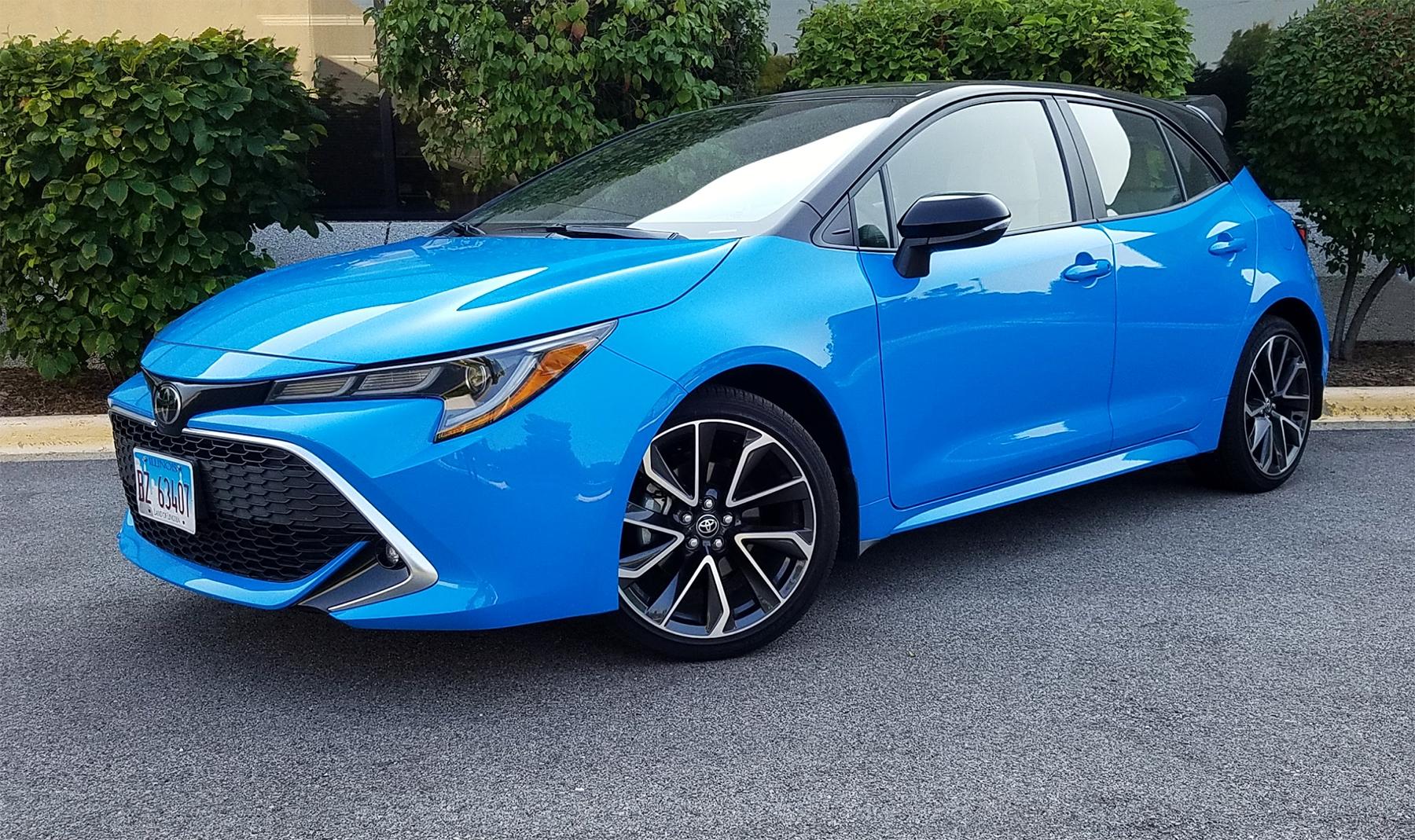
2020 Toyota Corolla Hatchback XSE in Blue Flame with black roof, spoiler, and side mirrors (a $500 option)

2020 Toyota Corolla Hatchback XSE
Class: Compact Car
Miles driven: 517
Fuel used: 17.7 gallons
| CG Report Card | |
|---|---|
| Room and Comfort | B+ |
| Power and Performance | B |
| Fit and Finish | B+ |
| Fuel Economy | A- |
| Value | B+ |
| Report-card grades are derived from a consensus of test-driver evaluations. All grades are versus other vehicles in the same class. Value grade is for specific trim level evaluated, and may not reflect Consumer Guide’s impressions of the entire model lineup. | |
| Big & Tall Comfort | |
| Big Guy | B |
| Tall Guy | B |
| Big & Tall comfort ratings are for front seats only. “Big” rating based on male tester weighing approximately 350 pounds, “Tall” rating based on 6’6″-tall male tester. | |
| Drivetrain | |
| Engine Specs | 168-hp 2.0L |
| Engine Type | 4-cylinder |
| Transmission | 6-speed manual |
| Drive Wheels | Front-wheel drive |
Real-world fuel economy: 29.2 mpg
Driving mix: 45% city, 55% highway
EPA-estimated fuel economy: 28/37/31 (city/highway/combined)
Fuel type: Regular gas
Base price: $23,240 (not including $955 destination charge)
Options on test vehicle: Adaptive headlights ($415), black roof/spoiler/side mirrors ($500), carpet mat package ($249) TRD air filter ($79), black emblem overlays ($129), door-sill protectors ($165), mudguards ($129), rear-window spoiler ($375), door-edge guard ($125), rear bumper protector ($89)
Price as tested: $26,450
Quick Hits
The great: Peppy engine with cooperative manual transmission
The good: Sporty driving personality
The not so good: Corolla Hatchback’s legroom isn’t as good as its sedan sibling; bobtail body design, sloped rear roofline, and high load floor make for disappointing cargo capacity
More Corolla price and availability information
CG Says:
Year two of Toyota’s remake of the Corolla product line is all about the sedan, completely redone for 2020 in the wake of the hatchback’s release as a ’19 model. It’s little surprise, then, that the hatch was fundamentally left alone in its second model year while the twelfth-generation sedan caught up.

The XSE is the sportiest trim level in the Corolla Hatchback lineup. It comes standard with racy-looking 18-inch machined alloy wheels, but the rear roof spoiler is a $375 option.
Some things did move the needle a little bit. Android Auto smartphone compatibility was added, and the hatchback lineup added a Nightshade edition, a black-trim automatic-only version of the base SE. Oh, and the Corolla became a Consumer Guide “Best Buy” in the compact-car class.
As it did in 2019, CG sampled an XSE, the top-level hatchback, which has a 2020 starting price (with delivery) of $24,195, an increase of $285 from ’19. In a way, this latest test car was a cross between the two XSEs we drove in 2019, with the stylish two-tone interior of one car but the 6-speed manual transmission from the other. We have yet to drive a current-generation Corolla hatchback that isn’t colored bright “Blue Flame” blue, but at least the ’20 tester came with its roof, rear spoiler, and exterior mirrors all painted black, a $500 option. (The spoiler is an option of its own apart from the paint treatment.) An extra-cost group of black overlays for exterior badges finished the look. With all options, the test car topped out at $26,450.
Quick Spin: 2019 Toyota Corolla Hatchback XSE (Manual)
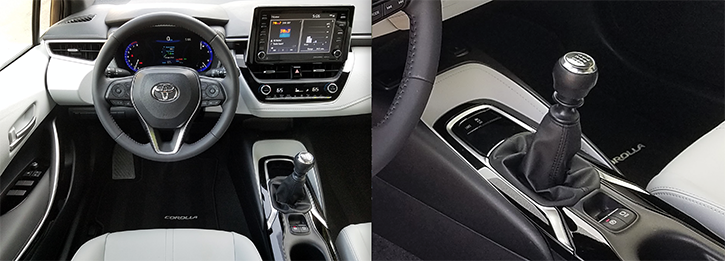
The Corolla Hatchback’s interior design is dynamic yet ergonomically agreeable, and it’s highlighted by sturdy materials and good assembly quality. The manual transmission–an increasing rarity these days–adds to the fun factor.
That said, there is an impressive roster of standard equipment in the XSE, starting with 18-inch alloy wheels, heated power mirrors, LED headlights and taillights, cloth-and-leather upholstery, heated front seats, a power-adjustable driver’s seat, leather-wrapped tilt/telescoping steering wheel, dual-zone automatic climate control, keyless access and starting, blind-spot monitoring, and the Toyota Safety Sense 2.0 suite of driving aids (except for lane-tracing assist deleted from manual-transmission cars). Infotainment falls to the Audio Plus system with HD and satellite radio, expanded remote-services capability, Android Auto/Apple CarPlay/Amazon Alexa compatibility, 6-speaker AM/FM radio, auxiliary and USB ports, Bluetooth wireless capability, and Wi-Fi.
Test Drive: 2020 Volkswagen Golf TSI
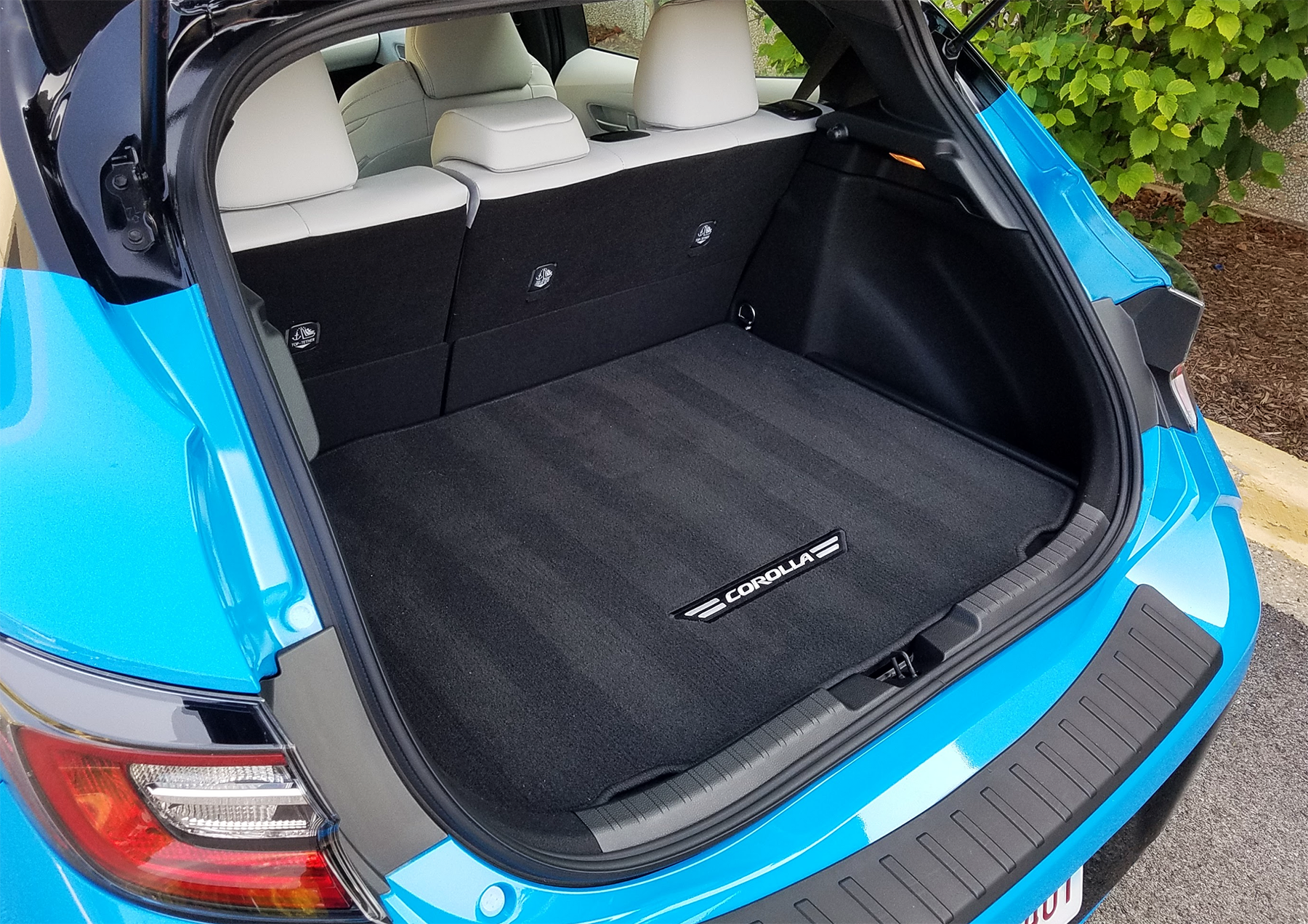
The Corolla Hatchback’s cargo capacity is compromised by a high load floor and a sloping rear roofline; there’s 17.8 cubic feet behind the rear seats.
Shift throws from the 6-speed transmission are a little long, but they’re easy to get right—which is good considering that the 2.0-liter 4-cylinder engine isn’t overburdened with a lot of low-end torque. Drivers will be downshifting frequently to keep the 168-horsepower powerplant in a happy place. Fun-to-drive character has its price, though, and it is paid out at the gas pump. The stickshift Corolla’s EPA estimates (28/37/31 mpg city/highway/combined) aren’t as good as the optional automatic continuously variable transmission gets. Our experience in 2019-20 has more or less hewed to those projections.
Front-seat passenger room is good for the class; there’s just enough rear legroom for most adults but headroom is somewhat limited. The flat-floored cargo bay has practical space behind the rear seats, but 60/40-split rear seats fold flush with the load floor for lots more capacity.
As for materials and controls, padded soft surfaces cover the middle of the instrument panel and the tops of the dash and front doors. Virtual driving controls are clearly displayed; the audio system is easy to reach and simple to use. Convenient rotary dials are used to select temperature, but other climate controls are buttons with function icons that can be difficult to read at a glance. Interior storage is managed by a good-size glove box, a smallish covered console box, an open bin at the front of the console, long pockets in the front doors, and pouches on the backs of the front seats. The console and pull-down rear armrest host cup holders, and each rear-door armrest carries a bottle holder.
Toyota isn’t coasting with the Corolla for 2021. It gains standard rear side airbags, sedans get a new Apex Edition with uprated suspension and unique trim, and a hatchback Special Edition packages the rear spoiler and special trim.
Test Drive: 2020 Honda Civic Hatchback Sport Touring

In top-line XSE trim with the 6-speed manual transmission, the Toyota Corolla Hatchback does an admirable job of blending everyday commuter-car practicality with eye-catching styling and a fun-to-drive personality.
Click below for enlarged images
Listen to the very entertaining Consumer Guide Car Stuff Podcast
2020 Toyota Corolla Hatchback XSE Gallery
2020 Toyota Corolla Hatchback

Quick Spin: 2021 Toyota Supra 2.0
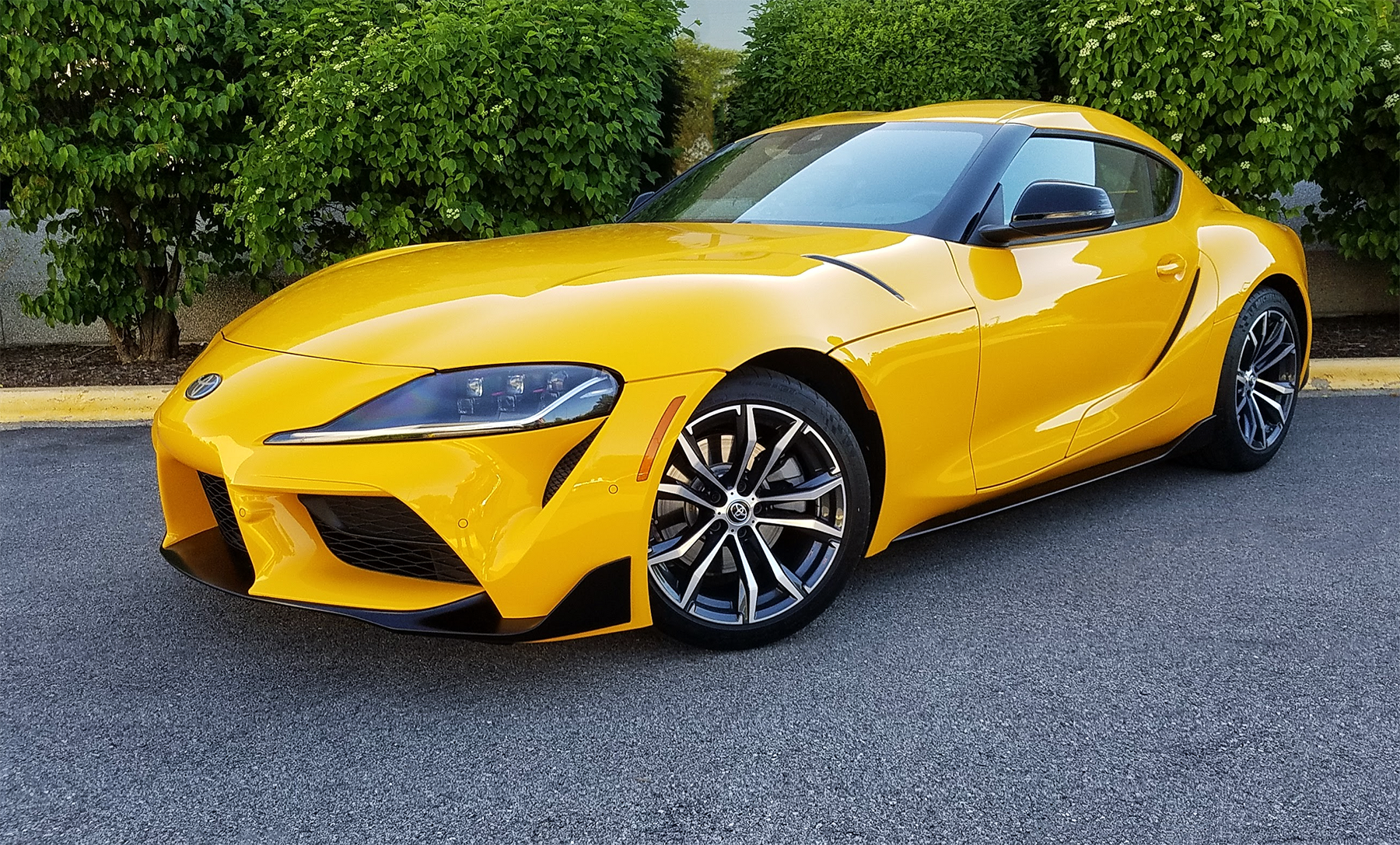
2021 Toyota Supra 2.0 in Nitro Yellow (a $425 option)
2021 Toyota Supra 2.0
Class: Premium Sporty/Perfomance Cars
Miles driven: 129
Fuel used: 4.6 gallons
| CG Report Card | |
|---|---|
| Room and Comfort | B |
| Power and Performance | B- |
| Fit and Finish | B |
| Fuel Economy | B+ |
| Value | A |
| Report-card grades are derived from a consensus of test-driver evaluations. All grades are versus other vehicles in the same class. Value grade is for specific trim level evaluated, and may not reflect Consumer Guide’s impressions of the entire model lineup. | |
| Big & Tall Comfort | |
| Big Guy | B- |
| Tall Guy | C |
| Big & Tall comfort ratings are for front seats only. “Big” rating based on male tester weighing approximately 350 pounds, “Tall” rating based on 6’6″-tall male tester. | |
| Drivetrain | |
| Engine Specs | 255-hp 2.0-liter |
| Engine Type | Turbo 4-cyl |
| Transmission | 8-speed Automatic |
| Drive Wheels | rear |
Real-world fuel economy: 28.0 mpg
Driving mix: 30% city, 70% highway
EPA-estimated fuel economy: 25/32/28 (city, highway, combined)
Fuel type: Premium gas required
Base price: $42,990 (not including $955 destination charge)
Options on test vehicle: Safety & Technology Package ($3485; adds adaptive cruise control, blind-spot monitor with rear cross-traffic alert, parking sensors with emergency braking function, navigation, 12-speaker JBL audio system, wireless Apple Car Play, and Supra Connected Services), Nitro Yellow paint ($425)
Price as tested: $47,855
Quick Hits
The great: Nimble handling; communicative steering; price advantage over 6-cylinder Supra
The good: Quick acceleration; very respectable fuel economy for a high-performance sports car
The not so good: Some complicated infotainment controls, low-slung cockpit can make entry/exit tricky, stingy cargo space, enthusiasts will bemoan lack of a manual transmission
More Supra price and availability information
CG Says:
Toyota brought back its storied Supra nameplate last year on a racy-looking two-seat coupe that shares its underpinnings and 6-cylinder powertrain with the BMW Z4 roadster. For 2021, the Supra’s six gets a 47-horsepower boost (from 335 to 382 hp), and the lineup gains an entry-level model with a 2.0-liter 4-cylinder engine—the subject of our review here.
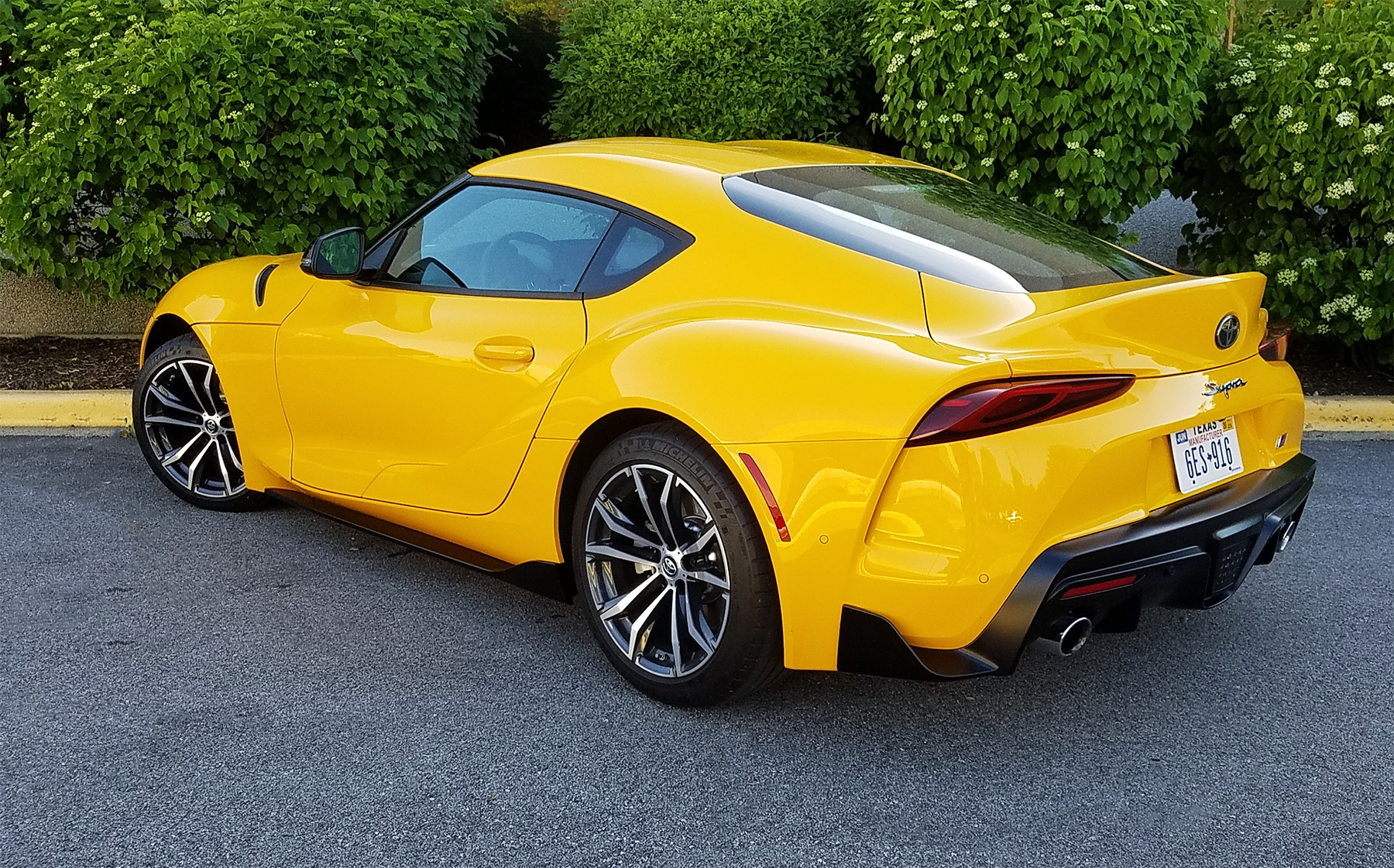
Combine the Supra’s dramatic bodywork with the extra-cost Nitro Yellow paint, and you’ve got a truly eye-grabbing car.
The new 4-cylinder Supra has the obvious benefit of a significantly cheaper starting price: $42,990, a full $8000 cheaper than the $50,990 base MSRP of the 6-cylinder-powered Supra 3.0. Even with destination, vibrant extra-cost Nitro Yellow paint, and the Safety and Technology Package (which is essentially fully loaded, save for accessory-type items such as carbon-fiber mirror caps, a carpeted cargo mat, and the like), the 2.0’s bottom-line price of our test vehicle came in at about $3K less than the 3.0’s starting price.
Test Drive: 2019 BMW Z4 sDrive30i
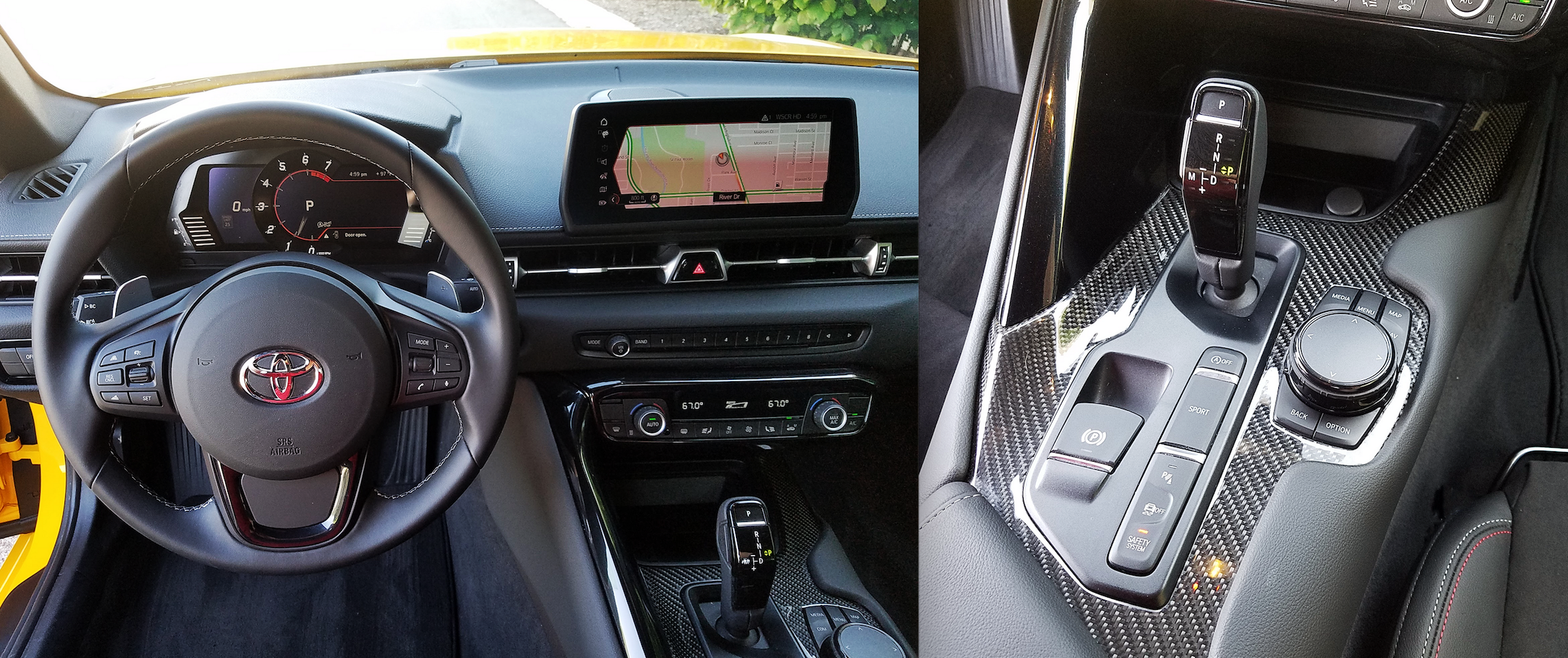
The steering-wheel badge is Toyota, but the majority of the interior components and controls are straight from the BMW parts bin. Even though the 2.0 lacks some of the features of the 3.0 models, the ambiance here is upscale.
Like the rest of the Supra’s underpinnings, the turbo 4-cylinder engine comes from BMW Z4—it’s the same basic powerplant that’s in the Z4 sDrive30i model, and its horsepower and torque ratings are also the same—255 hp and 295 pound-feet. Not surprisingly, the four does a bit better than the six in the fuel-economy department. It’s EPA-rated at 25 mpg city/32 highway/28 combined—that’s 3 mpg better overall than the Supra 3.0.
Test Drive: 2020 Toyota Supra 3.0 Premium
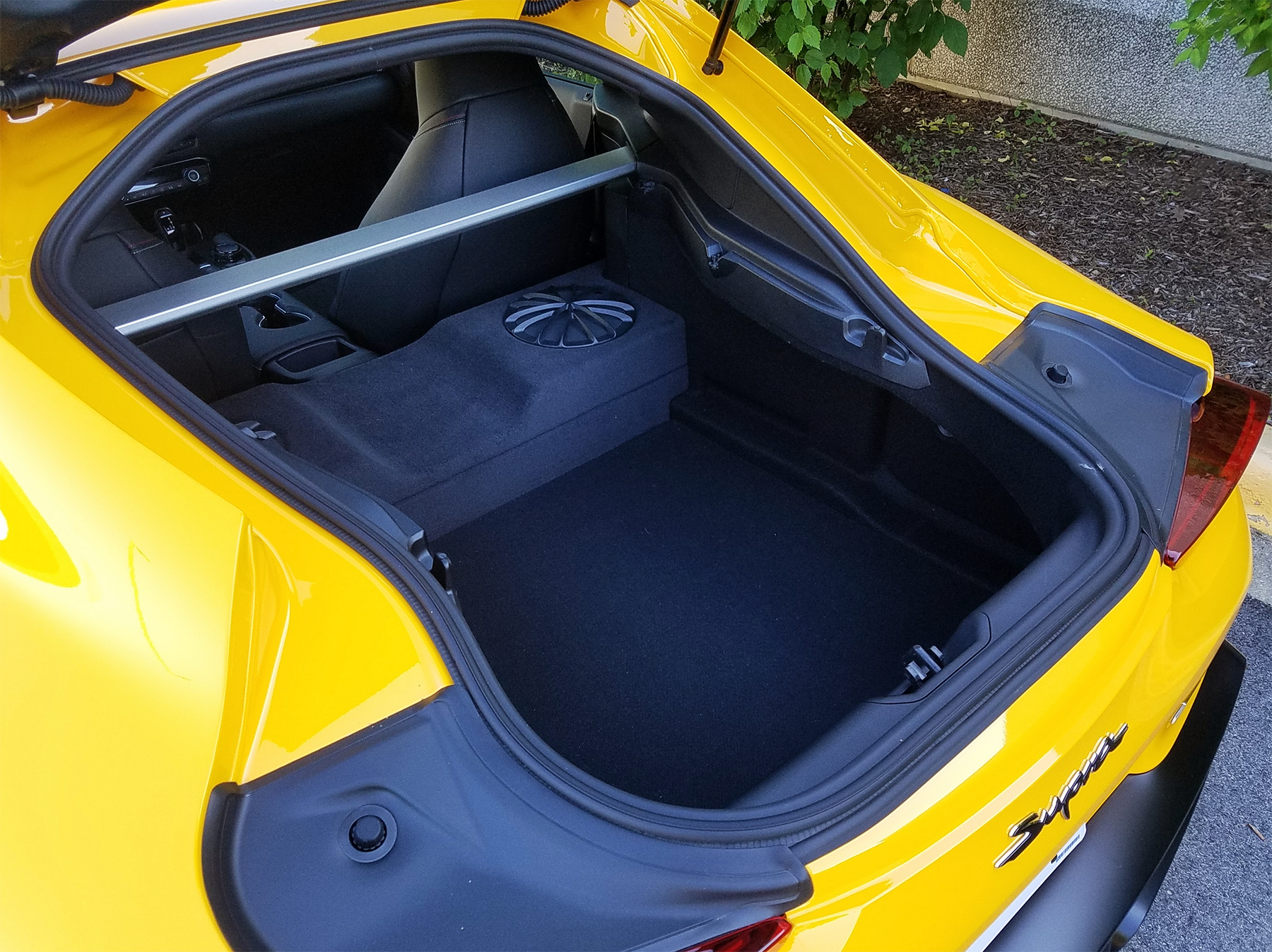
Luggage capacity isn’t a primary concern among Supra buyers, but there’s 9.9 cubic feet of capacity here–enough for a couple good-sized suitcases. Plus, the hatchback design makes the cargo area a bit easier to access.
We were fans of BMW’s excellent turbo four in the Z4 sDrive30i we tested, and we’re fans of it here. This is a snarky engine that pulls strongly from most any speed, with barely a hint of turbo lag; the 255-hp rating feels conservative by the seat of our pants. We’re also fans of the refined but aggressive exhaust note—one of the best, most-exotic 4-cylinder tones we’ve heard in a while.
The Supra’s lack of an available manual transmission is a downer for traditional sports-car enthusiasts, but the responsive 8-speed automatic transmission is a pretty good consolation—it’s always alert, and gear changes in both casual and full-throttle acceleration are quick and smooth. We never caught the transmission getting confused or ruffled. Plus, the steering-wheel shift paddles worked great to summon quick, smooth shifts—but we rarely felt the need to use the paddles.
However, we did experience the same quirk we noticed in our 2020 Supra 3.0 tester when the vehicle is coasting to a stop—the transmission’s downshifts are often unusually pronounced, and they make for an awkward, non-linear feel. It takes practice and a deft touch on the brake pedal to come to a smooth stop.
Obviously, the 4-cylinder isn’t as quick as the 2020 Supra’s six or the newly muscled-up 2021 version—Toyota lists a 5.0-second 0-60-mph time for the four, and 4.1 seconds for the 2020 six, and 3.0 for the 2021 six. Still, this “junior” Supra gives up much less to its more powerful siblings in driver engagement and excitement than you might expect. In fact, when driving in the congested urban and suburban environs of our Chicagoland offices, we might prefer the 2.0 Supra to the 3.0 version. Speaking of that, the impressions we gleaned from our test of a 2020 Supra 3.0 Premium hold true here, so check out that review for more details.
Test Drive: 2019 Ford Mustang Shelby GT350
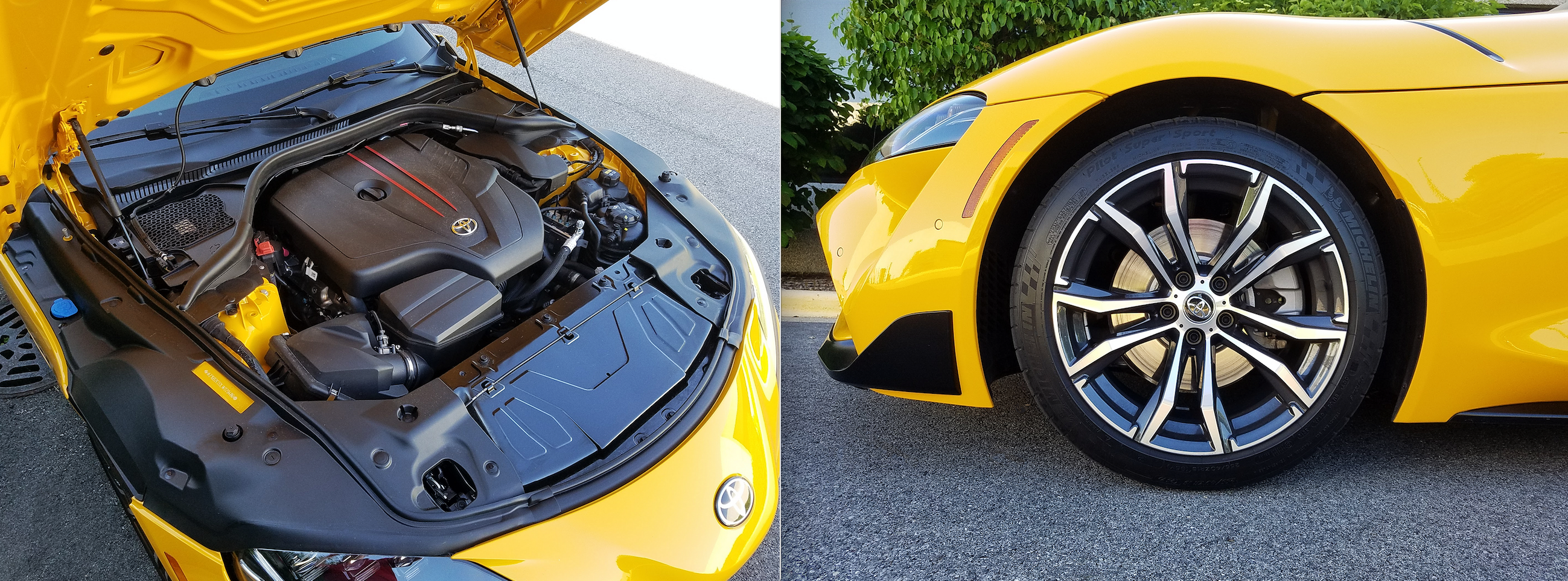
The Supra’s BMW-sourced turbocharged 2.0-liter 4-cylinder engine is officially rated at 255 horsepower, but in the lightweight Supra, it feels much stronger. Eighteen-inch cast aluminum wheels are standard equipment.
The Supra’s suspension tuning feels notably stiffer than the BMW Z4’s, which is in keeping with its pure sports-car mission over the more grand-touring focus of the Z4. The Supra 2.0 is a couple hundred pounds lighter than its 3.0 sibling, in part because it has smaller brakes, manual adjustable seats, and it doesn’t offer the 3.0’s active differential or adaptive suspension.
When you’re talking sports cars, “simpler” and “lighter” can be better in our book—especially because they also usually mean “cheaper.” The Supra 2.0 is a welcome addition to the model lineup that brings the cost of this German-Japanese hybrid down to a price point that makes it a lot more compelling. Hopefully that rumored manual transmission option will become available in the near future.
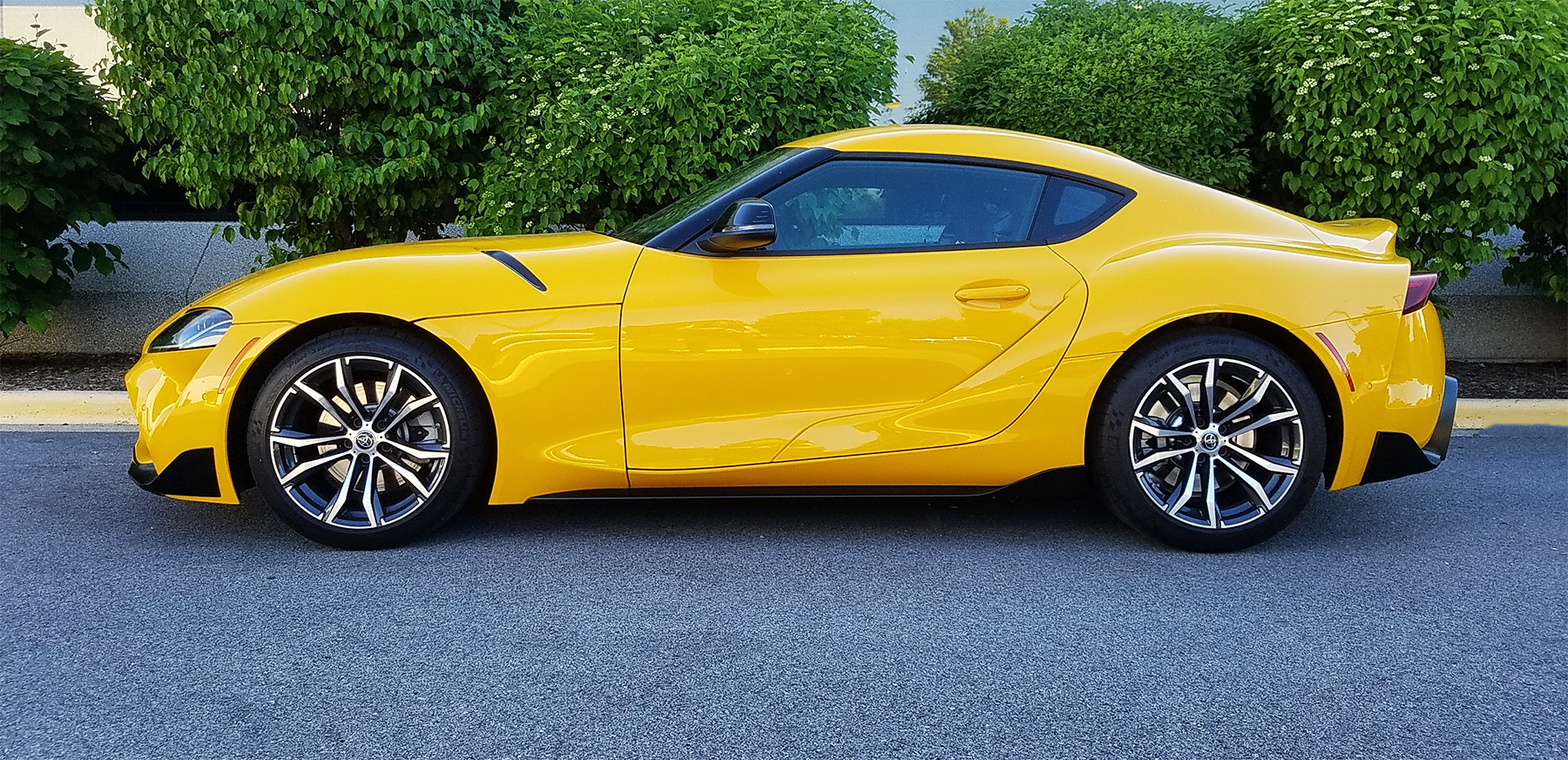
The new-for-2021 2.0 model brings the Toyota Supra’s price down to a shade under $43K to start, thus making this flagship sports car accessible to a broader range of enthusiasts. And even though it gives up 127 horsepower to its 6-cylinder sibling, the turbo 4-cylinder engine feels satisfyingly strong, and it rewards an engaged driver.
Consumer Guide Car Stuff Podcast, Episode 44: Pontiac’s Screaming Chicken, 2021 Ram 1500 TRX
2021 Toyota Supra 2.0 Gallery
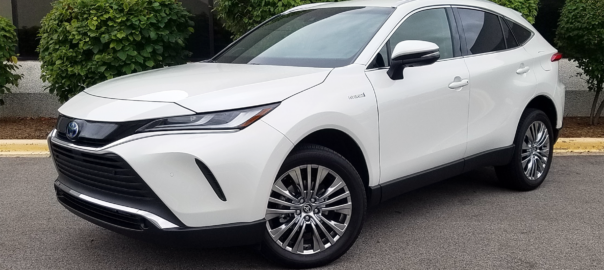
Test Drive: 2021 Toyota Venza XLE
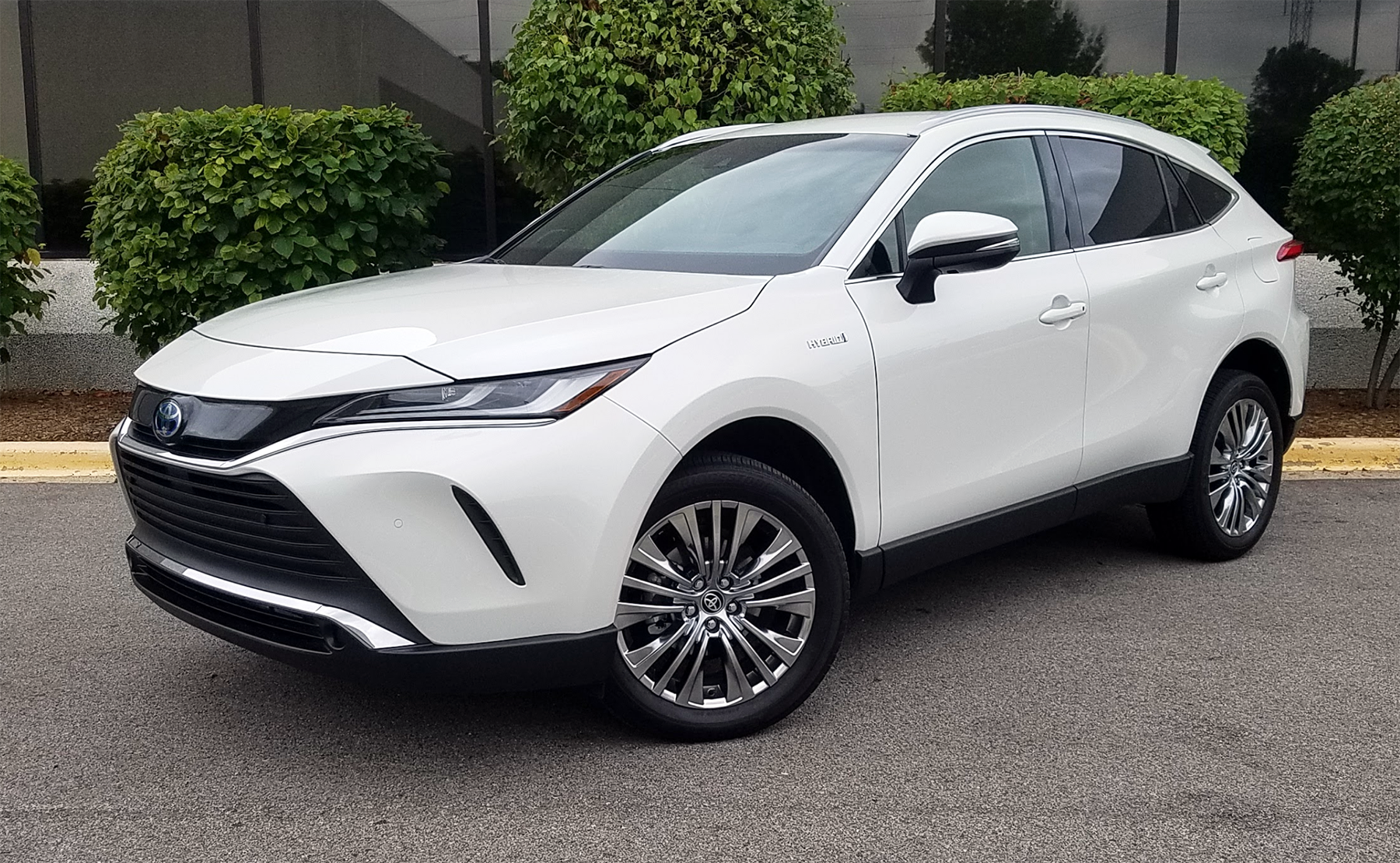
2021 Toyota Venza in Blizzard Pearl white paint
 2021 Toyota Venza XLE
2021 Toyota Venza XLE
Class: Midsize Crossover SUV
Miles driven: 141
Fuel used: 3.4 gallons
| CG Report Card | |
|---|---|
| Room and Comfort | B+ |
| Power and Performance | B |
| Fit and Finish | A- |
| Fuel Economy | A |
| Value | A |
| Report-card grades are derived from a consensus of test-driver evaluations. All grades are versus other vehicles in the same class. Value grade is for specific trim level evaluated, and may not reflect Consumer Guide’s impressions of the entire model lineup. | |
| Big & Tall Comfort | |
| Big Guy | A- |
| Tall Guy | A |
| Big & Tall comfort ratings are for front seats only. “Big” rating based on male tester weighing approximately 350 pounds, “Tall” rating based on 6’6″-tall male tester. | |
| Drivetrain | |
| Engine Specs | 219-hp 2.5L |
| Engine Type | 4-cylinder hybrid |
| Transmission | CVT automatic |
| Drive Wheels | AWD |
Real-world fuel economy: 41.5 mpg
Driving mix: 60% city, 40% highway
EPA-estimated fuel economy: 40/37/39 (city, highway, combined)
Base price: $36,000 (not including $1175 destination charge)
Options on test vehicle: 12.3-inch JBL Premium Audio ($2050)
Price as tested: $39,225
Quick Hits
The great: Smooth hybrid powertrain delivers excellent fuel economy; generous list of standard equipment, including safety features
The good: High-class interior trimmings; sleek styling inside and out
The not so good: Cargo volume isn’t as good as most class rivals; not all testers like capacitive-touch controls
More Toyota price and availability information
John Biel
If you need any further proof that there are lots of crossover sport-utilities on the market, the fact that automakers seem to be running out of names could be a tip-off. Consider that Blazer, Bronco, and Passport—all discarded nameplates from SUVs big and small—have lately come out of mothballs. Now Toyota is reaching into its recent past for Venza, the label you’ll find on the tailgate of a two-row midsize crossover added for the 2021 model year.

Toyota revives its Venza nameplate for 2021 on a sleekly styled 5-passenger midsize crossover SUV that comes solely with a hybrid powertrain and all-wheel drive. Upscale interior appointments also come standard.
The Venza badge previously graced a 5-passenger midsize crossover that Toyota sold in the U.S. from 2009 to 2015. It was a bit more car-like than the new product, and where the last-decade Venza came with a choice of 4-cylinder or V6 power and front- or all-wheel drivelines, the Venza for the Twenties is solely hybrid powered with AWD.
Test Drive: 2020 Volkswagen Atlas Cross Sport
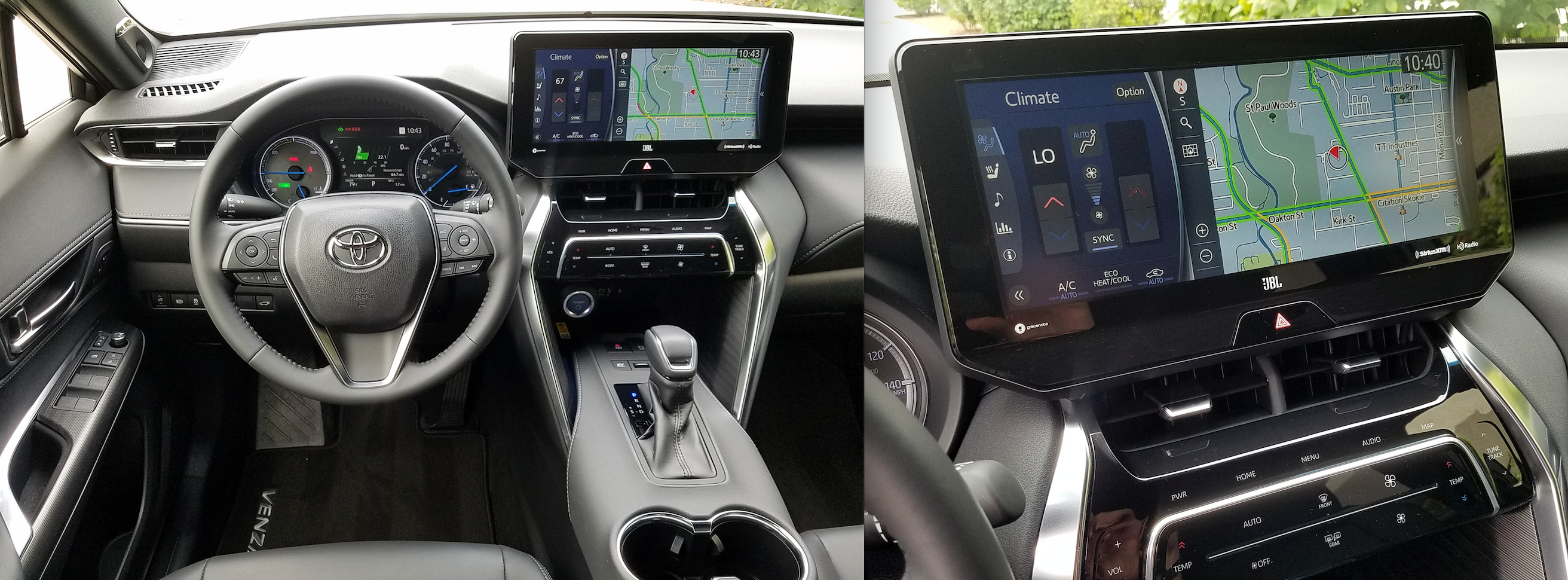
The Venza’s cabin has a pleasant, classy feel. Our XLE tester was equipped with the $2050 JBL Premium Audio option, which also adds a 12.3-inch infotainment touchscreen and Toyota’s Dynamic Navigation.
One way this Venza picks up where the last one left off is in model offerings. Ascending LE, XLE, and Limited trims are again available, with prices beginning at $33,645 including delivery. Consumer Guide sampled an XLE that started at $37,175 but tacked on 9-speaker JBL premium audio with navigation on a big 12.3-inch touchscreen to reach $39,225. (One extra we would have liked to see is the new “Star Gaze” panoramic roof that uses electrochromic technology to switch from transparent to frosted at the push of a button, but it’s a $1400 option reserved for the Limited.)
Test Drive: 2019 Honda Passport Elite

The rear-seat area is spacious and comfortable, though headroom can be tight for passengers above 6 feet tall. Central HVAC controls and dual USB charging ports are standard.
XLE standard equipment includes 19-inch super-chrome-finish alloy wheels, hands-free power liftgate, rear cargo cover, leather-wrapped steering wheel, “Softex” leatherette-and-fabric seats, power 8-way-adjustable driver’s seat, 7-inch color vehicle-information display, wireless smartphone charging, Smart Key access to doors and tailgate, push-button starting, and dual-zone climate control. The infotainment system (with 8-inch touchscreen) incorporates satellite and HD radio; Apple CarPlay, Android Auto, and Amazon Alexa compatibility; Bluetooth wireless technology; and Toyota Remote Services. Driver assists are a blind-spot monitor, rear cross-traffic alert, and front and rear parking assist with automated braking. Plus, all Venzas get Toyota’s Safety Sense 2.0 features: a pre-collision system with low-light pedestrian and bicycle detection, adaptive cruise control, lane-departure warning with lane-keep assist, automatic high-beam headlamps, and road-sign assist.
The Venza does for Toyota what many other manufacturers have done, and that is cover both ends of the midsize crossover space. Venza’s 105.9-inch wheelbase actually matches that of the compact RAV4, but at 186.6 inches overall, the newcomer is five inches longer between the bumpers—though eight inches shy of the 3-row Highlander. The Venza is built from the Toyota New Global Architecture K platform already in use by several other vehicle lines. It rides a suspension of struts in front and independent multiple links in back. Like some of today’s other two-row midsize debutantes (think Chevrolet Blazer and Volkswagen Atlas Cross Sport for instance), Venza is a little more style-driven than the usual midsize ute, with a more sweeping profile than the vehicles between which it fits.
Test Drive: 2019 Chevrolet Blazer Premier

With the rear seats up or down, the Venza’s cargo area isn’t as large as most two-row midsize SUV competitors’. There’s 28.8 cubic feet of cargo space behind the rear seats, and 55.1 cubic feet with the rear seats folded. For comparison, the Ford Edge’s respective cargo-area measurements are 39.2 cubic feet and 73.4 cubic feet.
How, then, can the Venza hope to stand out in an already-busy field? Two words: Powertrain. Driveline. Alone among U.S.-market crossovers it will be a) powered by nothing but a hybrid powerplant and b) driven through all four wheels. A 2.5-liter 4-cylinder engine is mated to three electric motors and a continuously variable automatic transmission (CVT) for 219 system horsepower. The AWD system electronically enlists a rear-mounted electric motor to drive the rear wheels when needed to help reduce front wheel slip or improve cornering. Up to 80 percent of available torque can be directed rearward.
The Venza is nicely responsive in around-town driving. It is quiet, and essentially seamless when going from electric to internal-combustion power. In highway driving, the CVT gives the effect of a prompt geared-transmission kickdown when passing power is called for. Three drive modes—“Normal,” “ECO,” and “Sport”—are available to drivers. Sport mode is supposed to sharpen throttle response, but from where this driver sat, any gain was evanescent. ECO tunes the throttle and climate-control system for greater fuel efficiency. The Venza handles very easily, effectively shelters passengers from most road shocks, and brakes with less of the vagueness that traditionally plagues hybrids.
Should I Buy a Car or Crossover?
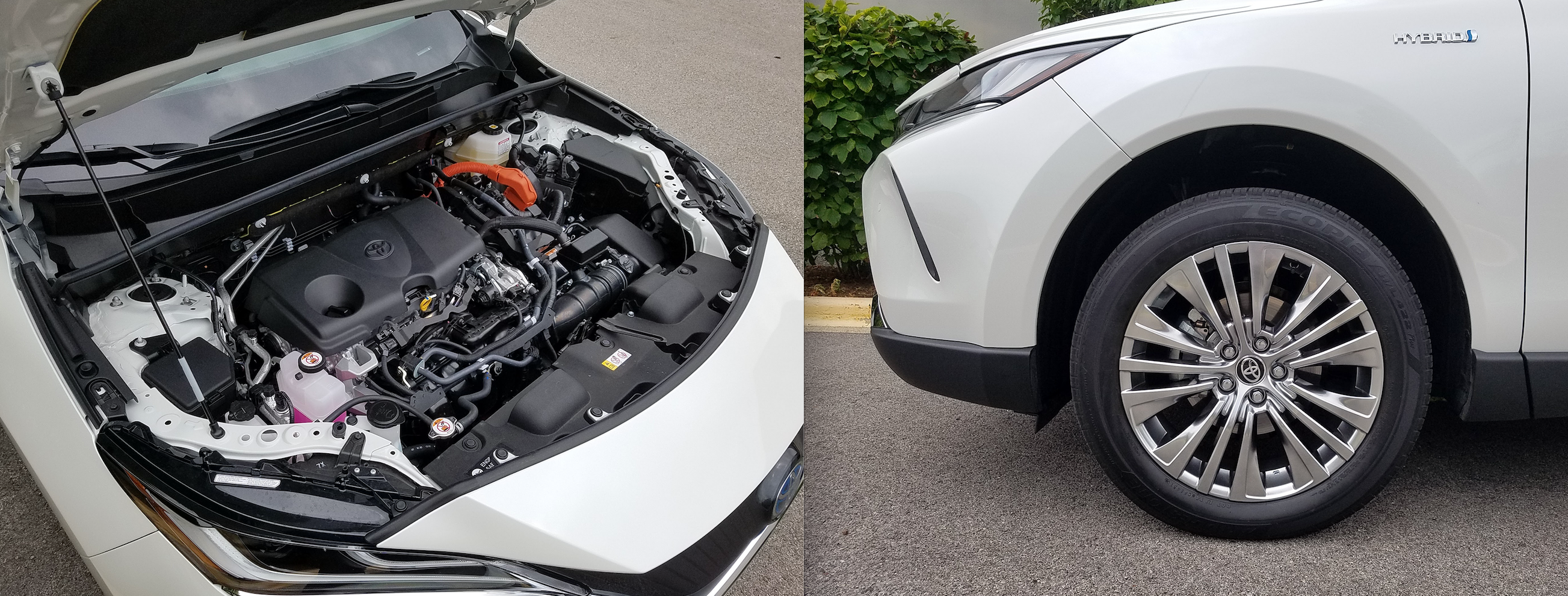
All Venzas come with the same powertrain: a 2.5-liter 4-cylinder paired with three electric motors for a total output of 219 system horsepower. XLE models come standard with 19-inch “super chrome” alloy wheels in place of the LE’s 18s.
Official EPA fuel-economy numbers are 40 mpg city/37 highway/39 combined on all Venza trim levels. Those are class leading numbers, and we actually did a bit better during our time with a pre-production test vehicle: In 141 miles of 60 percent city driving, we averaged 41.5 mpg.
Inside, four adult passengers will find fairly good head- and legroom. (The rear seat is slightly too narrow to get three grown-ups across it comfortably.) A compact lithium-ion battery pack for the electric motors fits under the rear seats, saving room for passengers and cargo. Owners can stash 28.8 cubic feet of stuff behind the second row. The space extends pretty far forward, but the roof rake that gives the Venza its sporting look reduces the height of objects that can be stored near the back. Rear seats fold flat for added capacity, and there’s some bonus hidden space under the floor if you’re willing to let your goods take their chances with the spare tire.
Test Drive: 2019 Toyota RAV4 Hybrid Limited

The Venza puts an emphasis on sleek, rakish styling. In addition the the full-width LED taillight, XLE and Limited models get a full-width center high-mounted stop light as well.
The XLE interior is comfortable and attractive for the price. There’s more soft-touch area than you’ll find in some pricier vehicles. Among other things, the colorful vehicle-information readout in the instrument cluster monitors hybrid-system function. Even on the uplevel infotainment system setup and access is fairly straightforward, but everything—including climate controls—is operated via capacitive controls which requires a lot of repetitive pushes to get desired settings. Personal-item storage is varied and abundant enough to be serviceable, but nothing more.
Some other Toyota crossovers may hold more passengers or be more space efficient. However, the revivified Venza plugs a gap in the brand’s SUV hierarchy with a stylish and nicely equipped alternative.
Car Shopping Tips: Test Drive Checklist
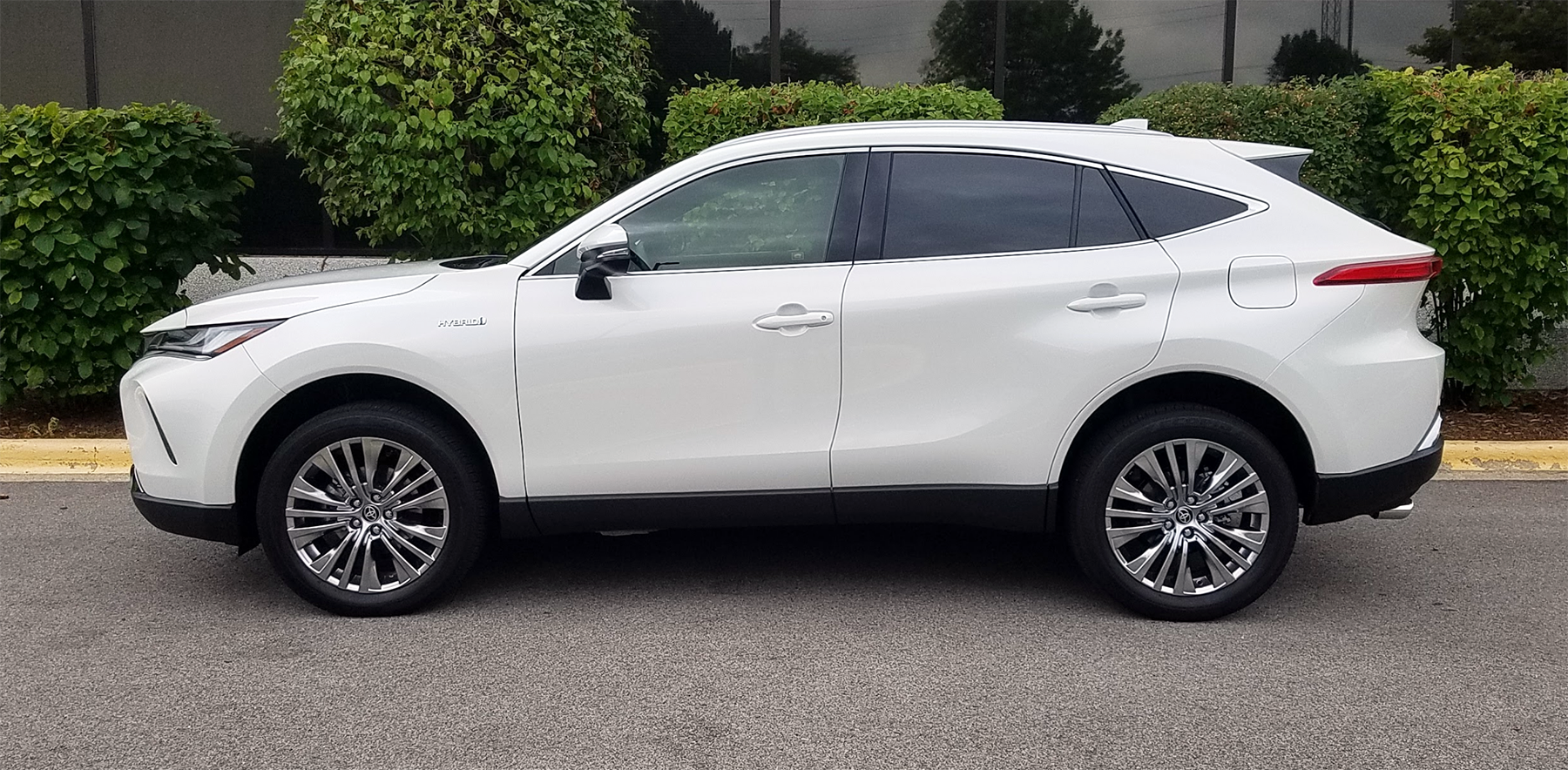
Outside of the Ford Explorer and Toyota’s own Highlander, the revived-for-2021 Venza is the only hybrid available in the mainstream midsize SUV class. Its excellent fuel economy is a key selling point, but the generous list of standard and available features, comfortable ride, and classy cabin also make the Venza a compelling choice.
Check out the Consumer Guide Car Stuff Podcast
2021 Toyota Venza XLE Gallery
Toyota Venza XLE

Test Drive: 2020 Toyota Highlander Platinum

2020 Toyota Highlander Platinum AWD in “Moon Dust” metallic silver paint (a $425 option)
 2020 Toyota Highlander Platinum AWD
2020 Toyota Highlander Platinum AWD
Class: Midsize Crossover SUV
Miles driven: 298
Fuel used: 14.0 gallons
| CG Report Card | |
|---|---|
| Room and Comfort | A- |
| Power and Performance | B+ |
| Fit and Finish | A |
| Fuel Economy | B |
| Value | B+ |
| Report-card grades are derived from a consensus of test-driver evaluations. All grades are versus other vehicles in the same class. Value grade is for specific trim level evaluated, and may not reflect Consumer Guide’s impressions of the entire model lineup. | |
| Big & Tall Comfort | |
| Big Guy | A |
| Tall Guy | A |
| Big & Tall comfort ratings are for front seats only. “Big” rating based on male tester weighing approximately 350 pounds, “Tall” rating based on 6’6″-tall male tester. | |
| Drivetrain | |
| Engine Specs | 295-hp 3.5-liter |
| Engine Type | V6 |
| Transmission | 8-speed automatic |
| Drive Wheels | AWD |
Real-world fuel economy: 21.3 mpg
Driving mix: 45% city, 55% highway
EPA-estimated fuel economy: 20/27/23 (city, highway, combined)
Fuel type: Regular gas
Base price: $48,800 (not including $1120 destination charge)
Options on test vehicle: Special color ($425), carpeted floor mats/cargo mat ($318), cargo cross bars ($350), universal tablet holder ($99)
Price as tested: $51,112
Quick Hits
The great: Expanded cargo volume; long list of comfort and convenience features; classy cabin trim
The good: Pleasant ride and driving manners; satisfying acceleration
The not so good: Third row seat is best suited for kids
More Highlander price and availability information
John Biel
More Highlander with more to it is Toyota’s plan for its 3-row midsize crossover sport-ute in 2020. It is redesigned on a new platform that’s 2.4 inches longer overall—with the added length at the rear to expand cargo volume—and gifted with several new convenience features. Considering the exceptional contenders in the class, particularly the all-new Kia Telluride and Hyundai Palisade, the moves were practically mandatory.

The Highlander grows a bit larger with its redesign for 2020, and most of that space comes aft of the rear wheels to improve cargo room. The roof cross bars on our test vehicle are a $350 accessory option.
The redone Highlander comes in five gas and four hybrid trim levels, all with a choice of front- or all-wheel drive. Consumer Guide tested a top-of-the-heap gas-engine Platinum with AWD. Base price, with delivery, is $49,920 (the torque-vectoring all-wheel drive adds $1950 to the cost of a Platinum), and the test vehicle came to $51,112 with extra-cost Moon Dust paint and a trio of relatively inexpensive options.
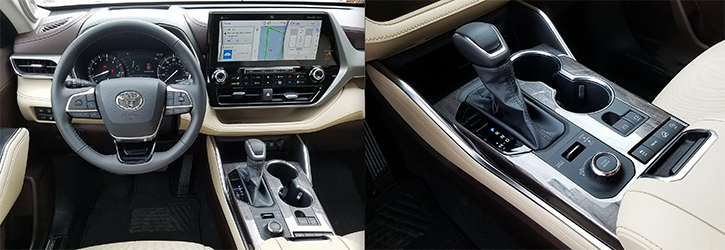
The top-line Highlander’s interior gets a bit ritzier with the 2020 redesign, boasting handsome satin-metal-look accents, upscale leather, and classy stitching. The center console houses drive-mode controls; an electronic parking brake; and on/off switches for the traction control, snow mode, hill-descent control, auto stop/start systems.
The sole engine offering for gas-only Highlanders is the carried-over 295-horsepower 3.5-liter V6 mated to an 8-speed automatic. (A 2.7-liter four that had been the base engine in prior years has been dropped for 2020.) Smooth and powerful overall, the V6 responds well from a standing start, and takes advantage of snappy transmission kickdown for good passing power in highway driving. There’s a slim improvement in eagerness when “Sport” mode is activated. In a 78-mile test stint with 30 percent city-type driving, this reviewer recorded 20.8 mpg. The EPA projects a V6 AWD Highlander for 20 mpg in city use, plus 27 mpg on the highway and 23 combined.
Test Drive: 2020 Ford Explorer Platinum
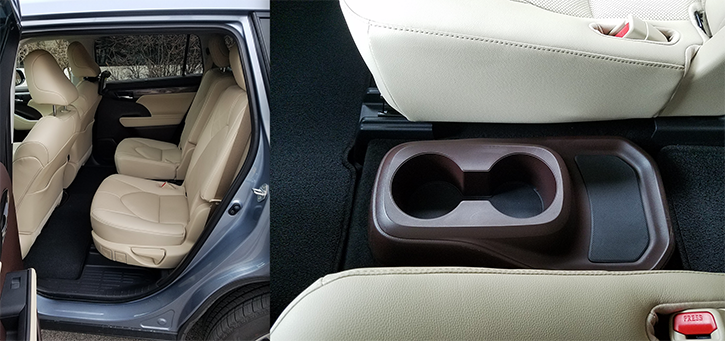
The Highlander’s second row is spacious enough for adults to ride in comfort. Our test vehicle was equipped with captain’s chairs (which come with a floor-mounted cupholder), but a bench seat is available for 8-passenger seating. Just visible on the front passenger seat back is the universal tablet holder, a $99 accessory.
Ride and handling are examples of classic crossover execution, with driving ease and passenger comfort at the forefront. The ’20 Highlander’s size gain isn’t just in body length. The wheelbase is stretched by 2.4 inches as well, a factor in ride that is nicely composed and resistant to most bumps. The only handling issue this tester encountered was a need for regular steering correction in blustery crosswinds.
First Spin: 2020 Toyota Highlander
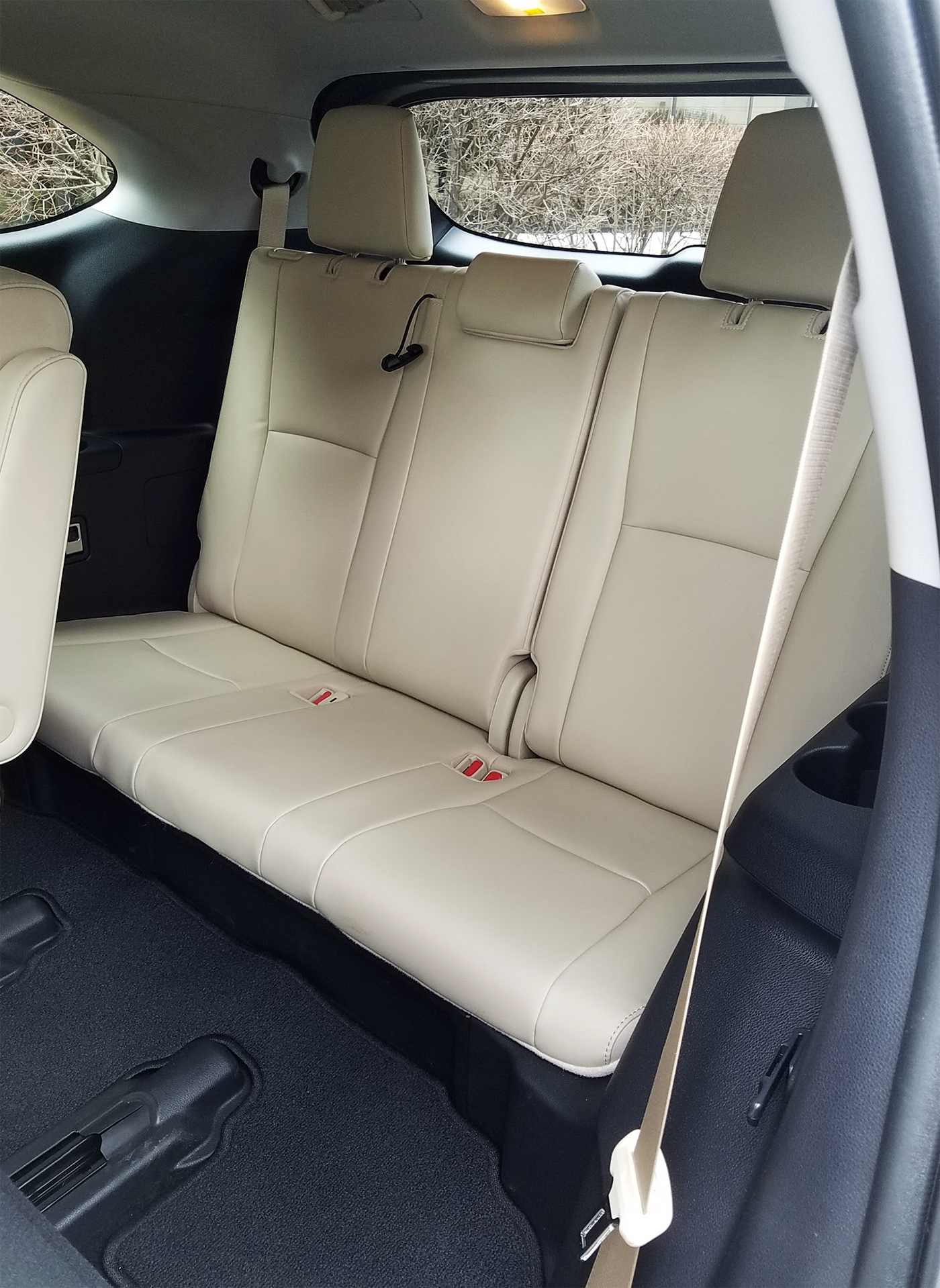
The Highlander’s third-row seat is best suited for children, and passengers small and limber enough to climb back there easily.
With the expanded body dimensions, cargo capacity is increased regardless of seating configuration—maximum capacity with the flat-folding second- and third-row seats retracted has been raised to 84.3 cubic from 78.6 cubic feet in 2019. The Highander Platinum comes standard with a hands-free power liftgate. A sizeable left sidewall indent and some wide, shallow space under the rear cargo floor (with a slot for stowing the cargo cover when not needed) add to the vehicle’s cargo-carrying flexibility.
Numerous features added for 2020 finally bring the Highlander up to par with the rest of the field. They include Apple CarPlay/Android Auto smartphone connectivity, Amazon Alexa compatibility, Qi wireless charging, a 10-inch head-up display (with speedometer, road-sign recognition, and navigation information in V6 models), a Wi-Fi hotspot, an infotainment touchscreen expanded to 12.3 inches, and a digital rearview mirror that can project an unobstructed camera image in the mirror. All are standard on the Platinum. Another upgrade, this one built into all Highlanders, is the 2.0 version of the Toyota Safety Sense package of safety and driver-assistance features: forward-collision warning with emergency braking and pedestrian detection, lane-departure warning and mitigation, automatic high-beam headlights, lane-trace assist, road-sign recognition, and full-speed adaptive cruise control.
Test Drive: 2020 Kia Telluride SX
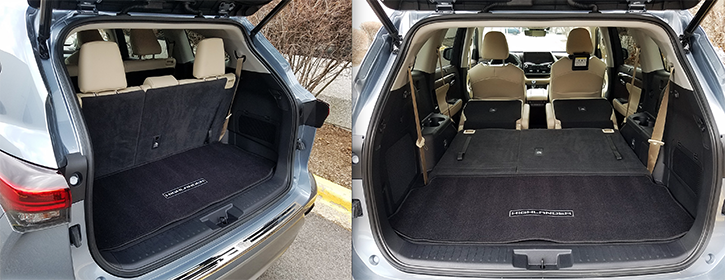
There’s 16 cubic feet of cargo space behind the Highlander’s third-row seats, which grows to 84.3 cubic feet with both the second- and third-row seats folded to create a smooth, level load floor.
There’s more to the Highlander Platinum. Other standard features are 20-inch alloy wheels, LED headlights and fog lights, heated power mirrors with puddle lamps, panoramic sunroof, and rain-sensing windshield wipers. Upholstery is leather. Power-adjustable front seats are heated and ventilated, and the second-row captains chairs are heated. The climate system is trizone; the audio setup is an 11-speaker JBL unit with satellite radio. Rear obstacle detection with automatic braking and blind-spot/rear cross-traffic alerts are included too.
Test Drive: 2020 Hyundai Palisade Limited
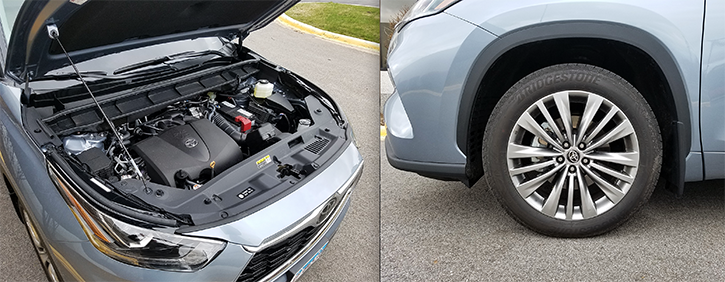
The lone powertrain offered on non-hybrid Highlanders is a carryover 3.5-liter V6 paired with an 8-speed automatic transmission. Twenty-inch alloy wheels are standard on Limited and Platinum models.
Passengers will find the top-line Highlander eminently habitable. There’s fine head- and legroom in the front two rows on comfortable seats. You’ll be able to fit actual adults in third-row seats, albeit not for long, and they can’t be taller than about 5-foot-10. Plenty of soft, pliable surfaces are deployed about the cabin. Audio controls are essentially intuitive and easy to work on the big, colorful horizontal touchscreen. (External volume and tuning knobs are handy.) Climate relies on lots of repetitive-push buttons, but second-row passengers get a thorough bank of controls that they can work for themselves. Personal items can be stashed in a big, configurable console box that also houses the flip-up wireless charger pad; the good-sized glovebox; a small pull-out drawer to the left of the steering column; a pouch on the back of each front seat; and large pockets in all doors. There are open cup holders in the console, in the floor-level tray between the second-row seats, and in the hard-plastic sidewalls of the third row.
It’s a good thing for the Highlander—and those thinking of buying one—that it has been brought in line featurewise with the new and well-equipped competitors in its group. But catching up isn’t leading. Shoppers in this segment have several excellent choices and can afford to be choosy. Perhaps they’ll find that more Highlander is just what they need.
Test Drive: 2019 Nissan Pathfinder Rock Creek Edition
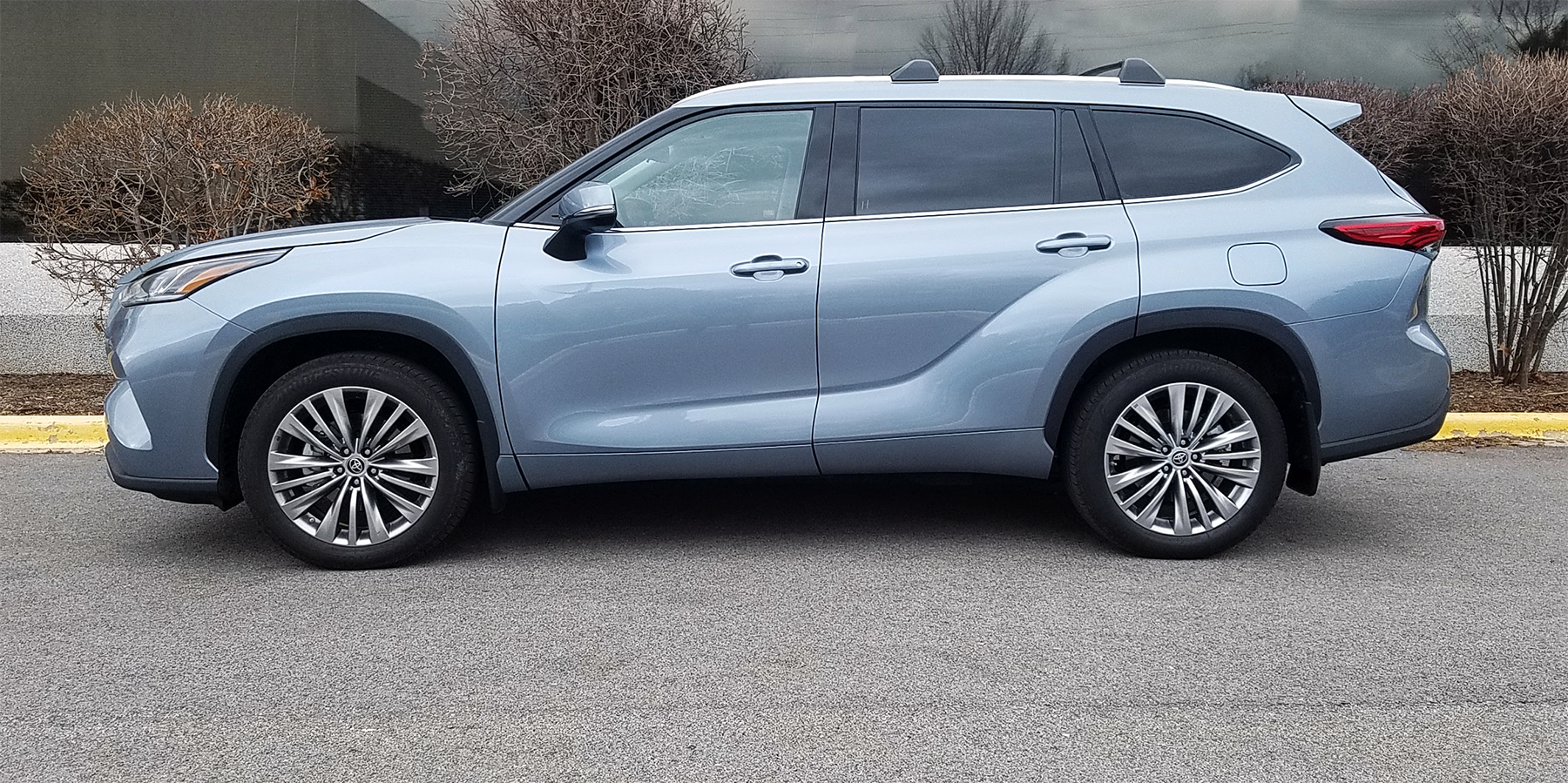
The redesigned 2020 Toyota Highlander gains a number of enhancements–including more space and some welcome new features–that help it keep pace with the formidable competition in its segment.
Listen to the Consumer Guide Car Stuff Podcast
2020 Toyota Highlander Platinum Gallery
2020 Toyota Highlander Platinum
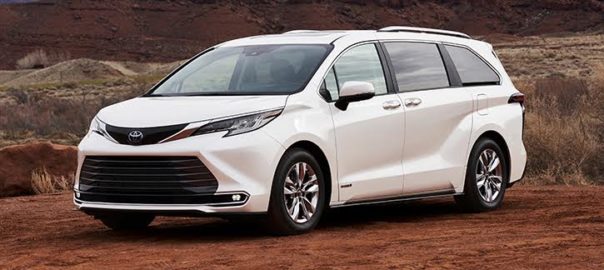
First Look: 2021 Toyota Sienna

2021 Toyota Sienna Limited
Toyota’s Sienna minivan is currently one of the oldest contenders in its segment, with a basic design that dates back to the 2010 model year. That’s about to change in the near future; Toyota unveiled the all-new fourth-generation version of its long-running minivan today via an online webcast. The 2021 Toyota Sienna is redesigned from the ground up, gaining flashier styling, a topline Platinum trim level, a host of new comfort and safety features, and a standard hybrid powertrain on all models.
2021 Toyota Sienna
Yep… all 2021 Siennas are now gas-electric hybrids. The new standard powertrain is a 2.5-liter 4-cylinder engine paired with two electric motors for a total output of 243 horsepower. Toyota estimates the new Sienna will achieve up to 33 mpg in combined city/highway driving. For the record, the Chrysler Pacifica is the only other minivan to offer a hybrid version. The Pacifica Hybrid is a plug-in-hybrid, which must be plugged in and charged for optimal efficiency, but it does offer up to 30 or so miles of pure-electric driving range on a full charge. The new Sienna is a “regular” hybrid that doesn’t need to be plugged in, but can only drive in pure-electric mode for short distances before the gas engine kicks in.
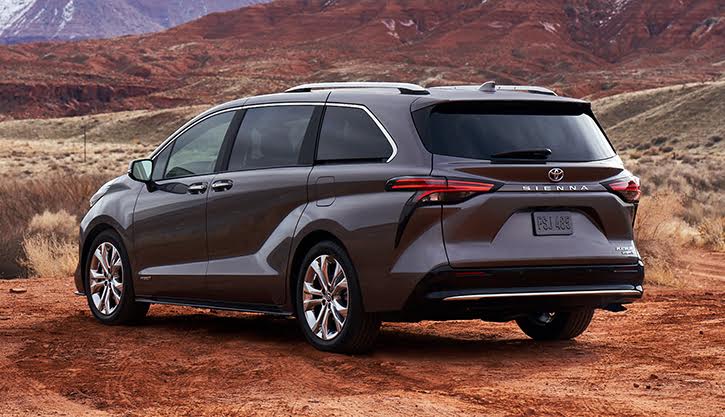
2021 Toyota Sienna Platinum
The Sienna retains its available all-wheel drive in addition to front-wheel drive, but the AWD system is now hybrid based; instead of a transfer case and a driveshaft from the gasoline engine, the rear wheels are powered by a separate electric motor. The gasoline engine only powers the front wheels, and the hybrid AWD system can send up to 100 of the vehicle’s torque to the front wheels, or split the torque at a ratio of up to 20 percent front/80 percent rear in slippery conditions. The Sienna can no longer lay claim to being the only minivan available with AWD—the refreshed-for-2021 Chrysler Pacifica is set to offer it as well—but the Sienna will be the only minivan to combine AWD with a hybrid powertrain.
Toyota’s press release stated that the Sienna’s design team “thought carefully about how to combine the practical attributes of a minivan with the emotional desire for having a more personalized driving experience.” The exterior styling is a bit more assertive than before, with curvaceous shapes and pronounced bodyside wheel-flare bulges. The sporty XSE trim level gets more-aggressive styling touches, including dark-finish 20-inch wheels and unique front and rear bumpers.
Inside, a driver-oriented “Bridge Console” center console places the shifter and cupholders within easy reach, while creating a large open area below for a purse or other cargo. The available “Super Long Slide” second-row captain’s chairs are aptly named; they slide up to 25 inches to optimize cargo space or provide limo-like legroom, and can be equipped with an ottoman feature for La-Z-Boy recliner comfort. There is also a stowable middle seat for eight-passenger capacity.
Test Drive: 2019 Toyota Sienna SE Premium AWD
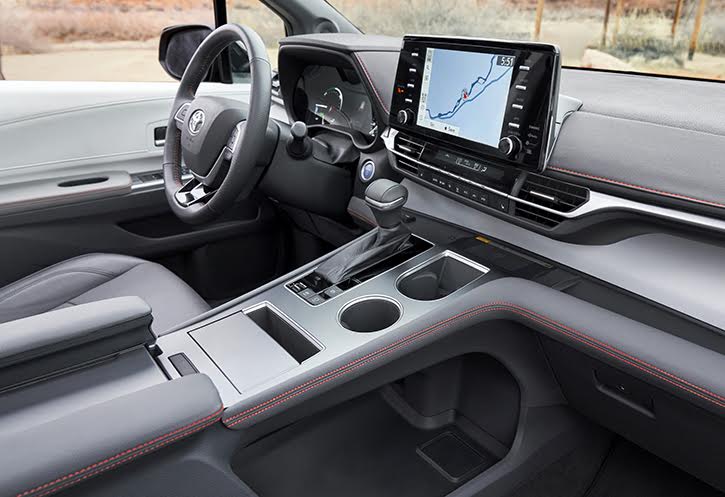
2021 Toyota Sienna XSE
The Sienna wouldn’t be a modern minivan if it didn’t offer a lengthy list of available comfort and convenience features in addition to those decadent second-row seats. Among these are a 10-inch color head-up display, power-tilt/telescopic steering column with heated steering wheel, hands-free power sliding side doors and rear liftgate, seven USB ports, Wi-Fi connectivity, 1080P HD rear-seat entertainment system, 12-speaker JBL-brand audio system, and up to 18 cupholders. There’s also an available on-board vacuum cleaner, on-board refrigerator, and a 1500-watt inverter with 120V AC outlet to power camping equipment.
All Siennas will come standard with Toyota’s Safety Sense 2.0 suite of safety equipment, as well as a new Rear Seat Reminder that alerts the driver to check the rear seat for passengers or cargo when exiting the vehicle. Available features include a digital rearview mirror, which can replace the regular mirror’s image with a digital display from the rear camera, in case passengers and/or cargo block the view; Toyota’s Driver Easy Speak feature, which uses the audio-system speakers and a microphone to transmit the driver’s voice to the rear seats; and a Bird’s Eye View Camera with Perimeter Scan, which provides a 360-degree view around the vehicle.
The 2021 Toyota Sienna is slated to go on sale in late 2020.
2020 Chicago Auto Show: 2021 Chrysler Pacifica AWD
CG Says:
Today’s minivan market is populated by nicely executed family haulers that offer a bewildering array of features—the class leaders are close enough in overall performance, space, and fuel economy that the best choice for you might boil down to which features you value the most.
The Chrysler Pacifica offers handy Stow ‘n Go second-row seats that fold into the floor for unbeatable passenger/cargo hauling convenience, as well as the efficiency of a plug-in-hybrid powertrain. The Honda Odyssey offers versatile Magic Slide second-row seats that adjust side-to-side as well as fore and aft, as well as the ability to control vehicle functions through a smartphone app.
Though it too offers a broad range of desirable equipment, the ace up the 2021 Toyota Sienna’s sleeve will likely be its standard hybrid powertrain, and the fact that it offers the efficiency of a hybrid powertrain with the all-weather traction of AWD. Toyota hasn’t yet released pricing, so we’ll be curious to see how competitive Toyota can keep the Sienna’s MSRPs while offering the hybrid powertrain across the board.
Forgotten People-Movers: More than 30 Minivans You Don’t Remember
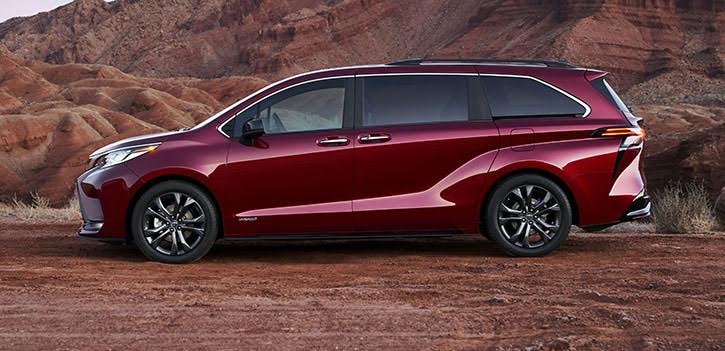
2021 Toyota Sienna XSE

